Ford Fiesta
The Ford Fiesta is a supermini marketed by Ford since 1976 over seven generations. It has been manufactured in the United Kingdom, Germany, Spain, Australia, Chile, Brazil, Argentina, Venezuela, Mexico, Taiwan, China, India, Thailand, and South Africa.
| Ford Fiesta | |
|---|---|
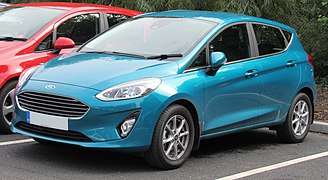 | |
| Overview | |
| Manufacturer | Ford |
| Production | 1976–present 1976–1980 and 2009–2019 (US) |
| Body and chassis | |
| Class | Supermini (B) |
| Body style | 3- or 5-door hatchback 4-door sedan/saloon (selected countries) 3-door van (Europe only) |
| Layout | Front-engine, front-wheel drive |
In 2008, the sixth generation Fiesta (Mark VI) was introduced worldwide, making it the first Fiesta model to be sold in North America since the Fiesta Mark I was discontinued at the end of 1980.
Ford has sold over 16 million Fiestas since 1976,[1][2][3] making it one of the best selling Ford marques behind the Escort and the F-Series.
Development
The Fiesta was originally designed by the project “Bobcat” team headed by Trevor Erskine (not to be confused with the subsequent badge engineered Mercury variant of the Ford Pinto) and approved for development by Henry Ford II in September 1972, just after the launch of two comparable cars – the Fiat 127 and Renault 5. More than a decade earlier, Ford had decided against producing a new small car to rival BMC's Mini as the production cost was deemed too high, but the 1973 oil crisis saw a rise in the already growing demand for smaller cars.
The Fiesta was an all new car in the supermini segment, and was the smallest car yet made by Ford. Development targets indicated a production cost US$100 less than the current Escort. The car was to have a wheelbase longer than that of the Fiat 127, but with overall length shorter than that of Ford's Escort. The final proposal was developed by Tom Tjaarda at Ghia, overseen by Ford of Europe's then chief stylist Uwe Bahnsen. The project was approved for production in late 1973, with Ford's engineering centres in Cologne and Dunton (Essex) collaborating.
Ford estimated that 500,000 Fiestas a year would be produced, and built an all-new factory near Valencia, Spain; a trans-axle factory near Bordeaux, France; factory extensions for the assembly plants in Dagenham, UK. Final assembly also took place in Valencia.[4]
The name Fiesta (meaning "party" in Spanish) belonged to General Motors, used as a trim level on Oldsmobile station wagons, when the car was designed and was freely given for Ford to use on their new B-class car. After years of speculation by the motoring press about Ford's new car, it was subject to a succession of carefully crafted press leaks from the end of 1975. A Fiesta was on display at the Le Mans 24 Hour Race in June 1976, and the car went on sale in France and Germany in September 1976; to the frustration of UK dealerships, right hand drive versions only began to appear in January 1977. Its initial competitors in Europe, apart from the Fiat 127 and Renault 5, included the Volkswagen Polo and Vauxhall Chevette. Chrysler UK were also about to launch the Sunbeam by this stage, and British Leyland was working on a new supermini which was launched as the Austin Metro in 1980.[5]
First generation (1976–1983)
| First generation | |
|---|---|
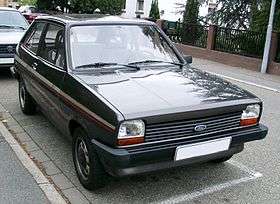 | |
| Overview | |
| Production | 1976–1983 |
| Assembly |
|
| Body and chassis | |
| Body style | 3-door hatchback 3-door panel van |
| Platform | Ford B platform |
| Powertrain | |
| Engine | 957 cc (58.4 cu in) Kent/Valencia I4 1,117 cc (68.2 cu in) Kent/Valencia I4 1,298 cc (79.2 cu in) Kent/Crossflow I4 1,597 cc (97.5 cu in) Kent/Crossflow I4 |
| Transmission | 4-speed BC4 manual |
| Dimensions | |
| Wheelbase | 2,286 mm (90.0 in) |
| Length | 3,565 mm (140.4 in) |
| Width | 1,567 mm (61.7 in) |
| Height | 1,360 mm (54 in) |
.jpg)
The Fiesta was initially available in Europe with the Valencia 957 cc (58.4 cu in) I4 (high compression and low compression options), and 1,117 cc (68.2 cu in) engines and in Base, Popular, Popular Plus, L, GL (1978 onward), Ghia and S trim, as well as a van. The US Mark I Fiesta was built in Cologne, West Germany, but to slightly different specifications; US models were Base, Decor, Sport, and Ghia, the Ghia having the highest level of trim.[6] These trim levels changed very little in the Fiesta's three-year run in the US, from 1978 to 1980. All US models featured the more powerful 1,596 cc (97.4 cu in) engine, (which was the older "Crossflow" version of the Kent, rather than the Valencia) fitted with a catalytic converter and air pump to satisfy strict Californian emission regulations), energy-absorbing bumpers, side-marker lamps, round sealed-beam headlamps, improved crash dynamics and fuel system integrity as well as optional air conditioning (a/c was not available in Europe). In the US market, the Ford Escort replaced both the Fiesta and the compact Pinto in 1981, competing with the Chevrolet Chevette and Chevrolet Cavalier.
A sporting derivative (1.3 L Supersport) was offered in Europe for the 1980 model year, using the 1.3 L (79 cu in) Kent Crossflow engine, effectively to test the market for the similar XR2 introduced a year later, which featured a 1.6-litre version of the same engine. Black plastic trim was added to the exterior and interior. The small square headlights were replaced with larger circular ones, with the front indicators being moved into the bumper to accommodate the change.
For the 1979 auto show season, Ford in conjunction with its Ghia Operations in Turin, Italy, produced the Ford Fiesta Tuareg off-road car. It was touted in press materials as "a concept vehicle designed and equipped for practical, off-road recreational use."[7]
Minor revisions appeared across the range in late 1981, with larger bumpers to meet crash worthiness regulations and other small improvements in a bid to maintain showroom appeal ahead of the forthcoming second generation.
Second generation (1983–1989)
| Second generation | |
|---|---|
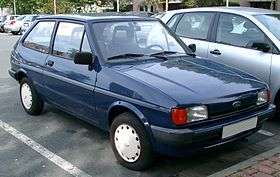 | |
| Overview | |
| Production | 1983–1989 |
| Assembly |
|
| Body and chassis | |
| Body style |
|
| Platform | Ford B platform |
| Powertrain | |
| Engine | 957 cc (58.4 cu in) Kent/Valencia I4 1,117 cc (68.2 cu in) Kent/Valencia I4 1,297 cc (79.1 cu in) Kent/Valencia I4 1,296 cc (79.1 cu in) CVH I4 1,392 cc (84.9 cu in) CVH I4 1,597 cc (97.5 cu in) CVH I4 1,608 cc (98.1 cu in) Diesel I4 |
| Transmission | 4-speed BC4 manual 5-speed BC5 manual CVT automatic |
| Dimensions | |
| Wheelbase | 2,286 mm (90.0 in) |
| Length | 3,565 mm (140.4 in) |
| Width | 1,567 mm (61.7 in) |
| Height | 1,360 mm (54 in) |
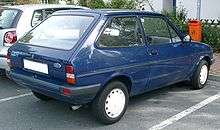
The Fiesta Mark II appeared in August 1983 with a revised front end and interior, and a bootlid mirroring the swage lines from the sides of the car. The 1.3 L OHV engine was dropped, being replaced in 1984 by a CVH powerplant of similar capacity, itself superseded by the lean burn 1.4 L two years later. The 957 and 1,117 cc Kent/Valencia engines continued with only slight alterations and for the first time a Fiesta diesel was produced with a 1,600 cc engine adapted from the Escort.
The new CTX continuously variable transmission, also fitted in the Fiat Uno, eventually appeared early in 1987 on 1.1 L models only.
The Mk2 Fiesta core range (excluding special editions) was made up of the following model variants; Popular, Popular Plus, L, Ghia, 1.4S (1986 onwards) and, finally, the XR2.[8]
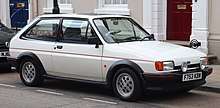
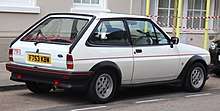
The second generation Fiesta featured a different dashboard on the lower-series trim levels compared to the more expensive variants. The XR2 model was thoroughly updated with a larger bodykit. It also featured a 96 bhp (72 kW) 1.6 L CVH engine as previously seen in the Ford Escort XR3, and five-speed gearbox (also standard on the 1.3 L CVH models), rather than the four-speed gearbox which had been used on the previous XR2 and on the rest of the Fiesta range. The engine was replaced by a lean-burn variant in 1986 which featured a revised cylinder head and carburettor; it was significantly cleaner from an environmental viewpoint but was slightly less powerful as a result (.008 bhp (0.0060 kW)).
A truly "hot" Fiesta was never produced by the factory to avoid impacting on sales of performance Ford Escort variants but many aftermarket conversions were available, the best-known being that by the English firm Turbo Technics boosting power to a well documented 125 bhp (93 kW), which easily outclassed its "standard" rivals. Ford appreciated the high quality of this conversion and was keen to look after its customers: the installation was undertaken by approved fitting centres and all the warranties remained valid after.
The facelifted Fiesta, facing competition from the Austin Metro, Fiat Uno, Nissan Micra, Peugeot 205, Toyota Starlet, Vauxhall Nova and the Volkswagen Polo was one of the UK's top superminis. In its best-ever year, 1987, over 150,000 Fiesta models were sold in the UK,[9] though it finished second in the sales charts to the Ford Escort. It was available in Japan, sold at Ford/Mazda dealerships called Autorama; it complied with Japanese government dimension regulations and the engine displacement was in the more favourable Japanese road tax bracket which helped sales.
Third generation (1989–1997)
| Third generation | |
|---|---|
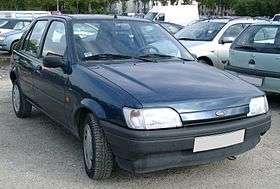 | |
| Overview | |
| Production | 1989–1997 |
| Assembly |
|
| Body and chassis | |
| Body style | 3/5-door hatchback 3-door panel van 3-door high cube panel van |
| Platform | Ford B platform |
| Related | Ford Ka Ford Courier |
| Powertrain | |
| Engine | |
| Transmission | 4-speed IB4 manual 5-speed IB5 manual CVT automatic |
| Dimensions | |
| Wheelbase | 2,446 mm (96.3 in) |
| Length | 3,743 mm (147.4 in) |
| Width | 1,606 mm (63.2 in) |
| Height | 1,321 mm (52.0 in) |
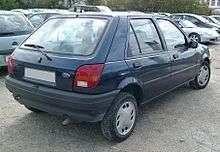
The third generation Fiesta Mark III, codenamed BE-13 was unveiled at the end of 1988 and officially went on sale in February 1989.
The car was based on a new platform ditching the old car's rear beam axle for a semi-independent torsion beam arrangement and looked radically different, addressing the principal weakness of the previous generation – the lack of a 5-door version, something that was by then available in its major rivals such as the Fiat Uno, Peugeot 205 and 106 and Opel Corsa/Vauxhall Nova. The other main change was to the running gear – the improved HCS (High Compression Swirl) version of the Kent/Valencia powerplant. The CVH units from the second generation were carried over largely unmodified. The diesel engine was enlarged to a 1.8L capacity.
The sports-model XR2i was launched in August 1989[9] with an eight-valve CVH (standing for "compound valve-angle hemispherical combustion chamber") engine with 104 PS (76 kW). This was the first Fiesta to have a fuel-injected engine. This was then replaced by a Zetec 16 valve version in 1992, which also saw the RS Turbo being supplanted by the RS1800 as the CVH engine was being phased out. The RS1800 shared its 1.8 litre Zetec fuel-injected engine with the 130 PS (96 kW; 130 bhp) version of the then current Ford Escort XR3i and had a top speed of 125 mph (201 km/h). The XR2i name was also dropped in early 1994, and the insurance-friendly "Si" badge appeared in its place on a slightly less sporty-looking model with either the 1.4 L PTE (a development of the CVH) or the 1.6 L Zetec engine.
With the introduction of the successor Mark IV, the Mark III was built and sold at the same time. To distinguish the car, trim levels were revised, and it was marketed as the "Fiesta Classic".[10] This version continued until production finally ceased in 1997.
Fourth generation (1995–2002)
| Fourth generation | |
|---|---|
_front.jpg) | |
| Overview | |
| Also called | Mazda 121 Mazda 121 Soho (South Africa) Ford Fiesta Street (Brazil) |
| Production | October 1995–December 2002 (Europe) 1996–2006 (Brazil) |
| Assembly | Almussafes, Spain (Ford Valencia) Dagenham, United Kingdom (Ford Dagenham) Cologne, Germany (CB&A) Saarlouis, Germany (SB&A) São Bernardo do Campo, Brazil (Ford Brazil) Chongqing, China (Changan Ford Mazda) Pretoria, South Africa |
| Body and chassis | |
| Body style | 3/5-door hatchback 3-door panel van 4-door sedan 3-door high cube panel van (Courier) 2 door coupé utility (Courier) |
| Platform | Ford B platform |
| Related | Ford Ka Ford Puma (first generation) Ford Ikon |
| Powertrain | |
| Engine | 1,299 cc (79.3 cu in) Kent/Endura-E I4 1,242 cc (75.8 cu in) Zetec-SE I4 1,388 cc (84.7 cu in) Zetec-SE I4 1,753 cc (107.0 cu in) Endura-D I4 1,753 cc (107.0 cu in) Endura-D I4 |
| Transmission | 5-speed IB5 manual CVT automatic |
| Dimensions | |
| Wheelbase | 2,446 mm (96.3 in) |
| Length | 3,828 mm (150.7 in) |
| Width | 1,634 mm (64.3 in) |
| Height | 1,320 mm (52 in) |
| Curb weight | 924 kg (2,037 lb) |
_rear.jpg)
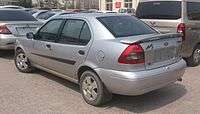
The Fiesta Mark IV (internal code name was BE91)[11] was launched in October 1995[12][9][13] and became Britain's best-selling car from 1996 to 1998, when it was overtaken by the all-new Ford Focus, a replacement for the Ford Escort.
The Mark IV benefited from new interior and exterior styling. It maintained similar dimensions to the Mark III along with the platform and the basic body structure, most noticeably the side door openings. The RS1800 and RS Turbo models were not carried over to the updated Fiesta range.
The model featured a range of new Zetec-SE engines, available in 1.25 L and 1.4 L forms, the 1.8 litre diesel engine was slightly modified for the Mark IV, now marketed as the "Endura DE". Lower specification models remained available with what would be the final edition of the Kent 1.3 L OHV engine, now known as Endura-E.
As an exercise in badge engineering, the Mazda 121 and Ford Fiesta Mark IV shared their design, were built on the same production lines and used almost all the same parts.[14] In the JD Power reliability surveys at the time, the Mazda was reported to be significantly more reliable and attracted higher levels of customer satisfaction, despite it being a slower seller than the Fiesta.
In Brazil a 1.0 litre (Endura Engine) version was available in Popular trim level. Also a 1.3 litre (Endura) and a 1.4 litre 16V (Zetec-SE) was available in CLX trim level; it was sold in Argentina and Chile. The UK trim level line up had relatively few changes over the years: (1995, Encore, LX, Si, Ghia; 1996, Ghia X added as range-topper; 1998, Si replaced by Zetec, petrol LX models briefly renamed Zetec LX, Ghia X models axed; 1999, Finesse added between Encore and Zetec).
In 1997, the Mark IV was introduced in South Africa, the first time the Fiesta had been sold in that market. Only one engine was available, the 1.3 litre Endura E. It subsequently won the South African Car of the Year award. The 1.3 litre engine was replaced with the 1.4 litre PTE (CVH) engine in 1999. It was also sold locally as the Mazda 121 Soho, although it is often referred to simply as the "Mazda Soho".[15]
The Mark IV was not sold in North America.
The German-built Ford Puma was based on the Mark IV, sharing its underpinnings. For this reason the 1.7 VCT engine from the Ford Puma has become an extremely popular engine swap into the Mark IV and Mark IV facelift Fiesta. This gives the popular hatchback an extra 100 cc over the previous largest engine size available, variable cam timing and better ratio gearbox while still retaining a factory finish as all components are a direct swap.
Specifications
| Engine type(s) | Inline-four engines: Petrol, Ford Kent/Endura-E (OHV), Zetec-SE (OHC), and Diesel (OHC) |
|---|---|
| Capacity | Petrol: 1,242–1,596 cc (75.8–97.4 cu in) Diesel: 1,753 cc (107.0 cu in) |
| Power | 59–91 bhp (44–68 kW) |
| Max. speed | 96–112 mph (154–180 km/h) |
| Acceleration | 0-62 mph (100 km/h): 1.25 Zetec: 11.9 s |
| Fuel efficiency | 38–46 mpg-UK (32–38 mpg-US or 7.4–6.1 L/100 km) |
Facelift
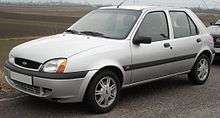
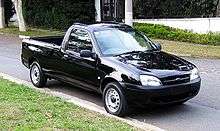
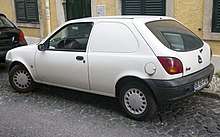
In 1999, the Fiesta received a secondary facelift[9][6] aimed at giving the car a New Edge look, with a Focus-inspired face, new bumpers and wheel designs. The facelift is sometimes referred to as Mark V in the United Kingdom and elsewhere.
Other changes include 1.6i 16V Zetec engine, fitted to the new Zetec S model, and later available in Ghia and Freestyle trims. New features such as side airbags and (after launch) the reintroduction of leather trim. An environmentally friendly E-Diesel model for 2001, with CO2 emissions of 120 g/km. The Lynx 1.8 TDDi engine (also introduced after launch).
The fourth generation facelift was the last generation of Fiesta to be built at Dagenham in England, and was indeed the final Ford model to be built at Dagenham prior to the closure of the car assembly plant in 2002. The internal code name of this Fiesta was still BE91. The UK trim level line-up consisted of: 1999, Encore, Finesse, Zetec, LX, Ghia; 2000, Zetec S added; 2001, E-Diesel added at bottom of range. Seeing the production of the fifth generation Fiesta, the Flight and Freestyle trims were respectively replaced by Finesse and Zetec.
In South Africa, the facelift used the Port Elizabeth-built 1.3 L and 1.6 L Rocam engines, instead of the European Sigma 16-valve engines. This model formed the basis of the Ford Ikon (code name C195), which is a four-door saloon designed for India, where Ford was then producing cars in a joint venture with Mahindra. The Ikon was also introduced in other developing countries, such as Brazil (where it is known as the Fiesta Sedan), South Africa, Mexico (where it was called Fiesta Ikon) and China, where saloons are preferred to hatchbacks. They are extremely reliable, and became one of Ford's successes. There were also four utility variants, the simplest being the "Fiesta Van" which was a three-door hatchback with the rear quarter windows blanked over and the rear seat omitted (in other words, a sedan delivery). Another van with a boxy rear body and stretched wheelbase used the Courier nameplate and formed the basis of two coupe utility models, one with the short doors of the 5-door hatchback and small quarterlights in the style of larger extended cab pick-ups, made in South Africa as the Ford Bantam; and another with the 3-door's longer doors and no quarter windows, made in Brazil as the Ford Courier.
The Fiesta was still Britain's best-selling supermini in 2001, by which time it was making use of a design over a decade old (though heavily updated visually and mechanically). In three-door form, it was sold alongside the fifth generation Fiesta from April to December 2002 and in its final years in Brazil, it was sold as the Fiesta Street until 2006.
Zetec S
The Zetec S was the highest Fiesta trim, and although its 1.6 L 16v Sigma engine was available in other Fiestas (such as the Freestyle) the Zetec S pushed out 101 bhp (75 kW; 102 PS),[16] and had major alterations to the suspension, with stiffer anti-roll bars and uprated brakes shared with the Puma.
The fifth generation facelift Zetec S has a sizeable following, with many websites dedicated to the vehicle. There is also a tuning culture devoted to this model, with reputable companies such as Milltek Sport and Shawspeed developing performance parts solely for the Sigma engine.
Specifications
| Engine type(s) | Inline-4: Petrol, Ford Kent/Endura-E (OHV), Zetec-SE (OHC), and Diesel (OHC) |
|---|---|
| Capacity | Petrol: 1,242–1,596 cc (75.8–97.4 cu in) Diesel: 1,753 cc (107.0 cu in) |
| Power | 59–103 bhp (44–77 kW) |
| Max. speed | 95–118 mph (153–190 km/h) |
| Acceleration | 0–60 mph (97 km/h) 9.9–16.9 seconds |
| Fuel efficiency | 38–53 mpg-UK (32–52 mpg-US or 7.4–4.6 L/100 km) |
Fifth generation (2002–2008)
| Fifth generation | |
|---|---|
_Ghia_5-door_hatchback_(2015-07-24)_01.jpg) | |
| Overview | |
| Also called | Ford Classic Ford Ikon |
| Production | 2002–2008 2002–2010 (Mexico) 2002–2014 (Brazil) |
| Model years | 2003–2008 2003–2010 (Mexico) 2003–2014 (Brazil) |
| Assembly | Almussafes, Spain (Ford Valencia) Cologne, Germany (CB&A) Saarlouis, Germany (SB&A) Camaçari, Brazil (Ford Brazil) Valencia, Venezuela Chennai, India (Ford India) Chongqing, China (Changan Ford Mazda) |
| Body and chassis | |
| Body style | 3/5-door hatchback 4-door saloon (Ikon) 3-door panel van |
| Platform | Ford B3 platform |
| Related | Ford Fusion Ford Ecosport Ford Figo Mazda2 |
| Powertrain | |
| Engine | Petrol: 1,299 cc (79.3 cu in) Endura-E I4 1,242 cc (75.8 cu in) Zetec-SE I4 1,398 cc (85.3 cu in) Zetec-SE I4 1,596 cc (97.4 cu in) Zetec-SE I4 1,998 cc (121.9 cu in) Duratec 20 I4 Diesel: 1,398 cc (85.3 cu in) Duratorq DLD-414 TDCi I4 1,560 cc (95 cu in) Duratorq DLD-416 TDCi I4 (2005 on) |
| Transmission | 5-speed IB5 manual 4-speed 4F27E automatic 5-speed Durashift EST |
| Dimensions | |
| Wheelbase | 2,486 mm (97.9 in) 2,488 mm (98.0 in) (Brazil) |
| Length | 3,918–3,924 mm (154.3–154.5 in) 3,930 mm (155 in) (Brazil, hatchback) 4,221 mm (166.2 in) (Brazil, saloon) 4,030 mm (159 in) (Trail) |
| Width | 1,685 mm (66.3 in) |
| Height | 1,464–1,468 mm (57.6–57.8 in) 1,451 mm (57.1 in) (Brazil, hatchback) 1,550 mm (61 in) (Trail) |
| Curb weight | 1,096–1,178 kg (2,416–2,597 lb) |
_Ghia_5-door_hatchback_(2015-07-24)_02.jpg)
On April 1, 2002, the all-new fifth generation car was unveiled. Production at Almussafes Plant started on April 29, 2002. Most engines were carried over from the previous Fiesta, but renamed "Duratec", as the "Zetec" name was now solely used for sportier models. The previous push-rod 1.3 L engine was initially available in the UK, but this was quickly replaced with a Rocam 1.3 L, both under the name Duratec 8v.[17]
Trim levels available initially were Finesse, LX, Zetec and Ghia, with limited edition variants soon following. The fifth generation was also the first Fiesta to feature the Anti-lock Braking System and passenger airbags as standard. This generation became the best-selling Ford Fiesta generation to date.
Engines available include 1.25 L, 1.3 L, 1.4 L, 1.6 L, 2.0 L petrol, plus 1.4 L 8v and 1.6 L 16v Duratorq TDCi common-rail diesels built in a joint venture with PSA.
This was the first Fiesta to be sold in Asia and Australasia (all 1.6 L LX 3dr/5dr, Zetec 3dr, Ghia 5dr), replacing the Kia-based Festiva. In Brazil and Argentina, a Fiesta saloon version was introduced in late 2004. A similar Fiesta saloon model, with a different front end, was released in India in late 2005. This Fiesta generation was ergonomically and mechanically more advanced than any previous generation. The 2005 facelift came with an improved exterior.
Marketing
South America
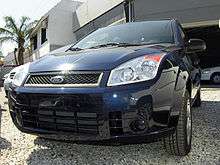
.jpg)
In Brazil, the engine options also include 1.0 L 8v Flex and 1.6 L 8v Flex engines called Rocam, that runs on ethanol, petrol or any mixture of both. The internal codename of this model is B256 (5-door) and B257 (3-door). In other Mercosur countries the Fiesta features a 1.6 L 98 bhp (73 kW) SOHC Zetec engine has a standard with the choice of either a 4-speed automatic or 5-speed manual transmission. There is also a 1.4 L 68 bhp (51 kW) diesel engine available. For the Colombian market a 1.0 L 8v Rocam engine was sold with a supercharger, producing 96 bhp (72 kW). This was discontinued in 2009 and replaced by the Mark VI imported from Mexico. In Chile the model is imported from Mexico because the Mercosur model does not meet the requirements of the country.
The South American market Fiesta was facelifted in early 2007 as a 2008 model, with new rectangular headlights and grille. In early 2010 the Fiesta was facelifted as a 2011 model, with new headlights and grille, very similar to those on the mark VI Fiesta available in other markets around the world, but keeping all other features nearly the same as the previous model. Its name varies from country to country, called "Fiesta One" in Argentina, "Fiesta Move" in Venezuela, and "Fiesta Rocam" in Brazil.[18][19][20]
Mexico
This generation was sold in Mexico until 2010, when it was replaced with the Ikon Hatch (a Ford Figo imported from India and still based on the fifth generation Fiesta). This new model coincided with the 2010 facelift and re-branding of the Fiesta Sedan to Ikon. Since the Ikon's discontinuation in 2012, the Ikon Hatch is sold alongside the sixth generation Fiesta.
India
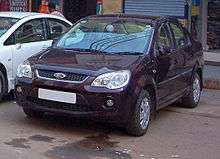
In the Indian market Ford produced the Ford Ikon (based on the Mark IV model) and the fifth generation Fiesta (with four-door, three-box bodywork only) in parallel for the saloon market until April 2011. The Fiesta was sold in India since September 2005, with either a 1.6 litre Duratec petrol engine (also in sports version namely 1.6 S) or with a 1.4 TDCi diesel engine. The bodywork was specific to the Indian market, not related to the Mark V sedan as sold in Latin America.[21] The car sold well from the beginning, with more than two thirds of initial sales being of the more economic diesel model.[22] In 2010, the Ford Figo was added to the range, a hatchback based on the Mark V model.
Production of the Ford Ikon was discontinued when the Bharat IV emission requirements came into effect for metropolitan areas.[23] Ford then announced the launch of the Fiesta Mark VI at a lower price and new features, including dual airbags, bringing the Fiesta in line with competitors such as the Honda City, Suzuki SX4, Volkswagen Vento and Hyundai Verna. In July, Ford introduced the sixth generation Fiesta, marketed in India only with saloon bodywork.[24]
Classic
Around the time of the introduction of the Mark VI, in April 2011, the name of the Mark V was changed to "Ford Fiesta Classic".[25]
After about a year on the market as the Ford Fiesta Classic, the rebodied version dropped the "Fiesta" portion and simply became the Ford Classic in July 2012. This coincided with a drop in prices and the introduction of a new variant called "Titanium".[25] It is offered with a 1.6 litre Duratec petrol engine or with a 1.4 TDCi diesel engine. The petrol version offers 101 PS (74 kW) while the diesel has 68 PS (50 kW).[26]
Japan
The Fiesta was briefly sold from 2004 through 2007, sharing its platform with the Mazda Demio. The only bodystyle was the 5-door hatchback, with the 1.6 litre engine in GLX trim, with the Fiesta ST offered only in 2005. The Fiesta Sportizm was sold in Japan and was limited to 50 cars. The model is based on the 1.6 litre GHIA and is equipped with sporty body kits, a rear spoiler and 'Sportizm' badging on the exterior and floormats. The Sportizm was only sold in the 'Colorado Red' colour.
Fiesta ST/XR4
_XR4_3-door_hatchback_(2015-07-03).jpg)
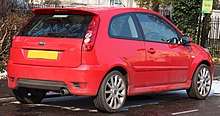
The Fiesta ST/XR4 was the performance model of this Fiesta. It includes a 2.0 L Duratec petrol engine rated at 150 PS (110 kW; 150 bhp) in standard form, with a top speed of 129 mph (208 km/h).[27] The Fiesta ST also features 17 in (43 cm) alloy wheels, disc brakes to all wheels, different front and rear bumpers, side skirts, body colour handles and bump strips, partial leather seats or an optional extra of heated full leather seats and a ST logo on the front seat backs and on the steering wheel.
In Australia, the Fiesta ST was sold as the Fiesta XR4. To stay in line with all sports model Fords sold in Australia it received the 'XR' badging, instead of the 'ST' badging used in Europe.[28]
The vehicle was unveiled at the 2004 Geneva Motor Show.[29]
Fiesta RallyeConcept
This is a British 3-door concept car designed by Ford RallyeSport and Ford Design Europe, designed for the Super 1600 rally. The 1.6 L Duratec engine was rated 200 bhp (150 kW; 200 PS). It includes four-two-one Arvin Meritor exhaust, 6-speed Hewland sequential gearbox, MacPherson strut front and twist-beam rear suspensions, 15-spoke magnesium wheels with 18" Pirelli P-Zero tyres.
The car was unveiled at the Birmingham Auto Show.[30]
Fiesta RS concept
This is a concept model based on the 2002 Fiesta RallyeConcept. It includes many of the RallyeConcept Fiesta features such as the cooling vents in the front bumper, deep side rockers, white ceramic-coated brake calipers and exhaust tips, and a large rear spoiler. It also includes 18-inch alloy wheels with low-profile tyres, extended wheel arches, and lowered and stiffened suspension. The engine is rated at over 180 bhp (130 kW).[31]
Facelift
In November 2005, a revised version of the fifth generation Fiesta was launched for the 2006 model year, also known as the Mk 6 facelift (Mk6.5). The exterior changes include new bumpers and grille, new headlamps, new rear lamps, redesigned door mirrors and thicker body side mouldings, with body coloured handles, mirrors and side mouldings on selected models. New vibrant exterior colours were added, to include 'Tango Red', 'Amethyst', 'Sublime' and 'Apple'.[32]
Inside, the redesign concentrated on improving the feeling of quality and space. This included a new fascia, with easier to read 'analogue' instruments, and a soft-feel upper section to the instrument panel, following criticisms of the hard and cheaply textured original. The facelift also included a range of new 'big car' technologies, including Voice Control, Bluetooth, trip computer, Electronic Automatic Temperature Control (EATC), rain-sensing wipers, automatic headlights, power-fold door mirrors, and MP3 connectivity. These new features were publicised in the UK through a 'Clever Fiesta, Stupid Dogbot' TV advertising campaign,[33] and Ford microsite.[34] In the UK, the car was initially available in Studio, Style, Style Climate, Zetec, Zetec Climate, Zetec S, ST and Ghia trim levels. This was the last Fiesta sold with the Ghia trim level.
The changes had an immediate effects on sales. After years being outsold by Vauxhall's Corsa, among others, in February 2006 Ford announced sales in the preceding month were up 25% on January 2005 for the previous model. Furthermore, the Fiesta captured the title of Britain's most popular supermini in both 2006 and 2007, for the first time since 2001.[35]
Pre-facelift styling
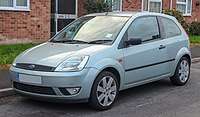 Front
Front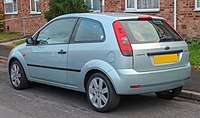 Rear
Rear
Post-facelift styling
_%E2%80%93_Frontansicht%2C_17._Juni_2011%2C_W%C3%BClfrath.jpg) Front
Front_%E2%80%93_Heckansicht%2C_17._Juni_2011%2C_W%C3%BClfrath.jpg) Rear
Rear
Limited Editions
The Zetec S "Anniversary" was a limited edition of 400 cars based on the Zetec S and included a Radian Yellow body, chequered roof, black mirrors and door handles, tinted glass, 16 in (41 cm) alloy wheels, black roof spoiler, sports seats, leather trim, an alarm, and an iPod socket.[36]
The car went on sale in the UK in March 2007 for £12,595. Despite the name, the Ford Fiesta was 31 years old when the anniversary model was released.[37]
The Zetec S "Celebration" was a limited (400 cars) edition based on the Zetec S and included a Celebration Green body, black and white chequered roof decal, unique identity number, chequered scuff plates and mats, full 'Ebony Haze' leather interior, privacy glass and Panther Black door mirrors, bodyside mouldings, roof spoiler, tailgate handle, 16 in (41 cm) alloy wheels, air conditioning, trip computer, electric windows, CD player with portable music connection socket, sports front seats and lowered sports suspension.
The car went on sale in the UK for £12,595.[38]
The Zetec S Red was a limited (500 cars) edition based on the Zetec S and included a Colorado Red body, black-and-white chequered roof decal, dark privacy glass on the rear windows, panther black door mirrors, door handles, bodyside mouldings, roof spoiler and tailgate handle; Quickclear heated front windscreen, ebony leather seats, 16 in (41 cm) alloy wheels, air conditioning and heated electrically operated door mirrors.
The car went on sale in the UK for £13,000.[39]
Fiesta ST
In 2008, Ford offered Mountune Performance options for Fiesta ST vehicles, available at specialist British Ford dealers beginning in March 2008. These were developed by Roush Technologies Ltd, which owns the Mountune Racing motorsport brand. The Mountune Performance Stage 1 (£1,435) includes a high flow catalyst and tubular manifold, and re-calibration of the engine to produce 165 PS (121 kW; 163 bhp). The Mountune Performance Stage 2 package (£1,838) adds new camshafts and valve springs to the basic package to deliver 185 PS (136 kW; 182 bhp).[40]
The ST 500 was a limited production (500 vehicles) model of the Fiesta ST. It includes 17 in (43 cm) 11-spoke black alloy wheels, red brake callipers and carbon fibre pattern interior trim. The interior also features a Sony audio system and ebony leather heated seats. The vehicle cost £15,000.[41]
Zetec Blue
In November 2007 Ford announced the special edition 'Zetec Blue', introduced as a 'swan song' for the UK Mk6.[42] The Zetec Blue was available as a 3 or 5-door, with a choice of the 1.25 and 1.4 petrol, and 1.4TDCi diesel engines. Prices started at £9,995; in between the existing Style Climate and Zetec Climate models. The seat trim was a unique blue derivative of the 'Kyoto' type featured in the Style Climate, and whilst the Zetec Blue didn't feature a chrome grille; the model was otherwise specified as the Zetec Climate model, adding additionally; 16" 7-spoke alloy wheels, Sony CD audio system with remote controls and premium speakers, and co-ordinated blue bezel, air vent and gaiter surrounds.[43] To boost final sales before the introduction of the Mk7, the specification of the Zetec Blue was increased in the summer of 2008, with the inclusion of Bluetooth and Voice Control, and the Technology Pack (automatic headlights, rain-sensing wipers, power-fold door mirrors) as standard, which was promoted until September 30, 2008.[44]
Specifications
| Engine type(s) | Inline-4: Petrol, Duratec (OHV), Zetec-SE and Duratec 20 (OHC), and Diesel, Duratorq DLD-414 and Duratorq DLD-416 (OHC) |
|---|---|
| Capacity | 1,242–1,998 cc (75.8–121.9 cu in) |
| Power | 60–150 bhp (45–112 kW) |
| Max. speed | 94–130 mph (151–209 km/h) |
| Acceleration | 0–60 mph (97 km/h) 18.8–7.9 seconds |
Sixth generation (2008–2019)
| Sixth generation | |
|---|---|
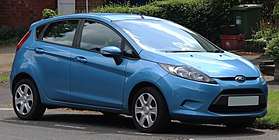 | |
| Overview | |
| Production | 2008–2019 |
| Model years | 2009–2017 2011–2019 (North America) |
| Assembly | Cologne, Germany (CB&A) Almussafes, Spain (Ford Valencia) Nanjing, China (Changan Ford Mazda, until 2012) Rayong, Thailand (AAT, 2010–2012)[45] Rayong, Thailand (FTM, 2012–2018) Hai Duong, Vietnam (Ford Vietnam) Tao-Yuan, Taiwan (2012–present) Chennai, India (Ford India)[24] Cuautitlán Izcalli, Mexico Valencia, Venezuela São Bernardo do Campo, Brazil (Ford Brazil, 2013–2019) Naberezhnye Chelny, Russia (Ford Sollers, 2015–present) |
| Designer | Stefan Lamm[46] |
| Body and chassis | |
| Body style | 3/5-door hatchback 4-door saloon 3-door van |
| Platform | Ford global B-car platform |
| Related | Ford EcoSport Mazda2 |
| Powertrain | |
| Engine | |
| Transmission |
|
| Dimensions | |
| Wheelbase | 2,489 mm (98.0 in) 2,487 mm (97.9 in) (van) |
| Length | 3,969 mm (156.3 in) 4,409 mm (173.6 in) (saloon) 3,917 mm (154.2 in) (van) |
| Width | 1,722 mm (67.8 in) 1,683 mm (66.3 in) (van) |
| Height | 1,481 mm (58.3 in) (2008–2010) 1,473 mm (58.0 in) (2011 on) 1,467 mm (57.8 in) (van) |
| Curb weight | 1,152–1,235 kg (2,540–2,723 lb) |
The sixth generation Mark VI[6] was shown in concept form as the Ford Verve at the Frankfurt Motor Show in September 2007 and marketed in principal European markets,[47] Australia and the United States. This model uses the new Ford global B-car platform.
Production started at Ford's Cologne plant in Germany in August 2008. A second plant in Valencia, Spain started production in early 2009. Productions in China, Thailand and Mexico started from late 2008 to 2010.[48] In Brazil the production of the hatch version started in the end of 2012, in São Bernardo do Campo in São Paulo. Soon, the saloon version will be produced in the same place.
A saloon version was launched in November 2008 at the Guangzhou Auto Show.[49] It started sales the following year in China and from 2010 it became available across Asia and North America.[49] It is not marketed in Europe, but marketed in Russia from 2015.[49]
Verve concepts
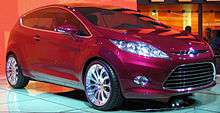
The Ford Verve concepts are a series of subcompact car concepts from Ford Motor Company which the sixth generation Ford Fiesta (Mark VI) was based upon.[50] The Ford Verve was intended to meet market demands for smaller, more fuel-efficient cars.[51] The Verve was created in both four- and three-door body styles. The 3-door hatchback and 4-door saloon versions of the Fiesta were both based on the Verve, with the 5-door hatchback and the 3-door van being their derivatives.[52]
First Verve concept
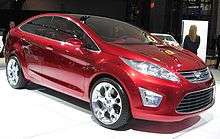
The Verve concept was first shown at the 2007 Frankfurt Motor Show. It continued Ford's Kinetic Design family styling theme, first seen on the Ford S-MAX. Martin Smith, executive director of design for Ford of Europe, described the Verve as "a chic, modern and individualistic statement for a sophisticated, fashion-aware generation."[53] The concept was created by a team of designers from Ford studios in Dunton, England, and Cologne, Germany.
The interior featured leather in different hues, along with multimedia equipment. The three-door hatchback featured a panoramic glass roof, pillarless side glass, LED headlamps, high-mounted LED taillamps, integrated tailgate spoiler and dark-chrome lower diffuser with integrated centre exhaust outlet. The car rode on 18-inch low-profile tyres mounted on two-piece, 12-spoke alloy wheels.
Second Verve concept
On November 19, 2007, Ford unveiled its second Verve concept. This second version took the form of a four-door notchback and was styled similarly to the Frankfurt version of the car. It was finished in frosted grape.[54]
Third Verve concept
Another four-door Verve concept car for North America was revealed at the North American International Auto Show in January 2008.[55][56] It was finished in Rouge Red, and unique to this version, featured a modified front fascia. The most notable changes were in a deeper upper grille, with Ford of North America's trademark 'three-bar' graphic, and a downsized lower inverted trapezoidal grille.
Reception
In late 2008 Motor Trend called the new generation of Fiesta a "superb little car" whose "greatest problem is that it's still a year away",[57] a reference to the fact that the Fiesta would not arrive in the US until early 2010. British magazine Auto Express called the car a "new class leader";[58] UK's Car Magazine said it was a "huge achievement" which will "please just about everyone".[59] The February 2009 issue of Britain's What Car? magazine named the new Fiesta "Car of the Year" and the Ford Mondeo "Best Family Car" and "Best Estate."[60] According to What Car?, there is plenty of space in the front of the cabin, however, the rear knee space is rather limited and the backrests do not fold flat onto the base, making an uneven floor for the expanded boot.[61]
The Fiesta was featured on episode 6 of series 12 of Top Gear in a series of "serious" road tests conducted by presenter Jeremy Clarkson, from escaping 'baddies' driving a Chevrolet Corvette C6 in the Festival Place Basingstoke shopping mall, to participating in an amphibious beach assault with the Royal Marines.
In its first two years since the latest generation Fiesta went on sale in October 2008, more than 940,000 Fiestas had been purchased by customers around the world, with 810,000 (86%) being sold in Europe (September 2010).[62]
Body styles
.jpg)

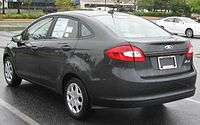
There are four body styles, including three- and five-door hatchbacks, four-door saloon, and a three-door van. They are sold separately depending on the country.
- Five-door hatchback
- Sold globally except India.
- Four-door saloon
- Originally available in China and other parts of Asia, later in North American and South American markets, and then in Australasia. In 2015, the saloon began production in Russia for the market.
- Three-door hatchback
- Sold in Europe (except Russia), Australasia, and select parts of Asia such as Singapore.
- Three-door van
- Sold only in Europe. Uses the same bodyshell as the three-door hatchback, modified with solid panels in place of the rear quarter windows and a flat load floor replacing the rear seats.
Equipment
_Zetec_5-door_hatchback_01.jpg)
The 2008 Fiesta includes Ford's Convers+ menu system, as seen on the Mondeo, S-MAX and Galaxy, and complemented by steering wheel button controls. Ford initially anticipated that over 85% of Fiesta orders would include this multifunction display. Other new equipment includes keyless entry with a 'Ford Power' starter button, reach and rake adjustable steering wheel, electric power steering, and a USB port for portable music players. Ford Easyfuel, the capless refuelling system recently introduced with the Ford Mondeo, will also be a feature, while 'ambient lighting,' casting a soft red glow over the interior, will be an option. For the 2011 US market model, the Ford Sync in-car communications and entertainment system will be available as an option.
UK trim levels for the new Fiesta include Studio, Edge, Metal, Style, Style Plus, ECONetic, Zetec, Zetec S, Titanium and Titanium Individual.
ECOnetic model
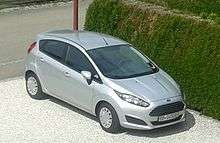
In 2008 Ford revealed details of an ECOnetic model, which Ford stated would emit 98g/km of carbon dioxide. The car was launched in 2009. It uses the 1.6 litre Duratorq TDCi diesel engine, but with an added diesel particulate filter. The Fiesta ECOnetic achieves its environmental credentials through weight loss and aerodynamic adjustments, and its emission figure exempts the car from UK vehicle excise duty. The ECOnetic gets an estimated fuel consumption of 65 mpg‑US (3.6 L/100 km; 78 mpg‑imp).[63] When tested on the highway mileage and emissions test schedules, on which hybrids are designed to perform well,[64] the ECOnetic outperforms the Toyota Prius.[65] The model will not be available in the US because, as Business Week noted, the company "doesn't believe it could charge enough to make money on an imported ECOnetic" and does not think it would sell enough of the model (350,000/year) to justify the $350 million in upgrades required at their Mexico plant to manufacture it in North America.[63]
Facelift (2013)
.jpg)
In 2013 (first introduced in show-cars in 2012) the Ford Fiesta in the European market received a facelift (called facelift, Mk 7.5 or Ford Fiesta 2013 model) which was the first to use the new trapezoidal grille, now used on the Ford Focus, Fusion and Mustang. Similar updates as the facelift-update in European market were introduced in the North American market as the Ford Fiesta 2014 model (see below). Trim levels in Britain became: Studio, Style, Zetec, Zetec S, Titanium, Titanium X and the newly introduced ST. Luxurious equipment from the Focus and Mondeo was also made available on the facelifted Titanium X model. Engines were also changed, with the 1.0 litre Ecoboost from the Focus debuting, with 100 and 120 hp, and a naturally aspirated version of the same engine producing 80 hp. A new facelift was introduced at the Torino Motor Show in June (some sources say that it was actually introduced at Paris Motor Show in late September 2012) featuring a new front and rear fascia and front fenders.
Second facelift (2017) in South American market
.jpg)
As the seventh generation Fiesta would not be offered in Latin America, Ford has extended the production of this sixth generation of Fiesta in Brazil. As the result, another facelift was introduced in Brazil and other Mercosur markets in November 2017.[66][67] For the first time, the Mercosur market Fiesta is offered with the 1.0 litre Ecoboost engine.[68] It featured a new front bumper, new alloy wheels, new headlights and LED taillights. It is also equipped with the updated SYNC 3 infotainment system.[69] The Fiesta was discontinued in Brazil in February 2019 without any direct replacement.[70][71]
Engine line-up in Europe
1.25 litre Duratec
The 1.25 Zetec engine produces 59hp(60bhp) for the STJA , STJB and STJC engines and produces a higher 82Bhp for the SNJA , SNJB , SNJC and SNJD engines . Both of which are available in a 5 speed manual variant .
1.0 litre Duratec Ti-VCT
All-new naturally aspirated engine will eventually replace 1.25 Duratec, and comes with 80 hp, as a 5-speed manual and start/stop.
1.0 litre Ecoboost
Award winning engine, producing either 100, 125 or 140 (Red/Black special editions) hp, with the manual or Powershift transmission (100 hp only).
1.4 litre Duratec
96 hp, comes usually as a 4-gear automatic or 5-gear manual
1.6 litre Duratec
120 hp, as a 5-speed manual. Soon to be replaced by 1.6 litre Duratec, with 120 hp and Powershift transmission.
1.6 litre Ecoboost
Exclusive to ST, this engine makes 180 hp (up to 197 horsepower on a 15-second "overboost"), with a 6-speed manual.
1.5 litre TDCi Duratorq
Replaces 1.4 TDCi, and soon 1.6 TDCi, with a hp output of 75 and 95 depending on model.
1.6 litre TDCi Duratorq
Top of the range diesel with one version, 95 hp, with the option of start/stop. Will be replaced by 1.5 TDCi 95 from the Ford Focus in the future.
Fiesta ST (2013–2019)
_Front.jpg)
_Rear.jpg)
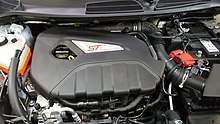
In 2011, Ford revealed the Fiesta ST concept based on the Fiesta MK6/MK7.[72] The final production model was announced at the Geneva Motor Show in March 2012.
The Fiesta ST is powered by a 1.6 litre Ford EcoBoost engine to deliver performance while still providing good fuel efficiency. The 1.6 litre Ford EcoBoost Turbocharged engine features Twin-independent Variable Camshaft Timing (Ti-VCT) and puts out 182 PS (134 kW; 180 hp) with 177 lb⋅ft (240 N⋅m) of torque, providing an acceleration time of under 7 seconds (0–100 km/h) and a top speed of 136 mph. This engine features "overboost," allowing delivery of up to 197bhp[73] for a maximum of 15 seconds.[73] In the US, Ford is permitted to market the engine offering its overboost power figure; by contrast, in other countries such as the UK, a manufacturer is not permitted to market an engine's temporary output.[73] The engine is mated to a 6 speed manual transmission which features Ford’s Torque Vectoring Control system to brake the inside front wheel to aid agility, and has three ESP modes. The car is expected to provide high fuel economy while not sacrificing performance, with Ford claiming higher fuel economy than the Volkswagen Golf GTI. The ST features a redesigned front fascia similar to the one seen on the Focus ST, a large rear spoiler, aggressive rear diffuser with a dual exhaust system, completed with 17-inch wheels on Bridgestone Potenza tires. On the inside, the ST provides heavily bolstered Recaro front seats (optional in North America with partial leather, and available with either partial leather or cloth-only in other territories) and sportier décor; North American versions are offered with the MyFord Touch infotainment system.
The Fiesta ST production model went on sale in both Europe and North America in 2013. In the North American market, the Fiesta ST became available in early 2013 for the 2014 model year, unveiled at the 2012 Los Angeles Auto Show as part of a larger mid-cycle refresh for the Fiesta.[74] The North American Fiesta ST is offered as a five-door hatchback variant (curb weight 2,720 lbs, 1,234 kg, manufactured in Cuautitlán Izcalli, Mexico) instead of the three-door hatchback offered in Europe, China, Australia, New Zealand and South Africa (curb weight 2563 lbs, 1163 kg, manufactured in Cologne, Germany).
The North American model is only sold in hatchback body and with four doors, and includes a 1.6 litre EcoBoost four-cylinder engine, six-speed manual transmission, overall steering ratio of 13.6:1, increased roll stiffness at rear axle, 15 millimetres lower body height than base model, electronic Torque Vectoring Control and 3-mode electronic stability control (standard, sport or off).[75]
The Ford Fiesta ST won Top Gear's Car of the Year for 2013.[76]
In 2016, Ford released the Fiesta ST200 limited edition in Europe. On the outside, it featured bespoke grey paint as the only colour available, and unique 17-inch black alloy wheels. Inside, it featured Recaro bucket seats and illuminated tread plates as standard. Power and torque were both increased. As the name suggests, power was up to 200 PS (147 kW), while torque was boosted to 214 lb⋅ft (290 N⋅m). The chassis remained the same, but torque vectoring (powered by braking the inside wheels rather than an active differential) helped to reduce understeer whilst cornering. Thanks to the increase in power and also to a shorter final drive ratio, 0-62 mph (100 km/h) was reduced to 6.7 seconds.
Powertrain
| Model | Years | Type | Power, torque@rpm |
|---|---|---|---|
| Petrol engines[77] | |||
| 1.0 L Duratec Ti-VCT 80 PS | From 2013 | 998 cc (60.9 cu in) I3 | 80 PS (59 kW; 79 bhp), 105 N⋅m (77 lb⋅ft) |
| 1.0 L EcoBoost 100 PS | From 2013 | 998 cc (60.9 cu in) Turbo I3 | 100 PS (74 kW; 99 bhp), 170 N⋅m (125 lbf⋅ft) |
| 1.0 L EcoBoost 125 PS | From 2013 | 998 cc (60.9 cu in) Turbo I3 | 125 PS (92 kW; 123 bhp), 200 N⋅m (148 lbf⋅ft) |
| 1.0 L EcoBoost 140 PS | From 2014 | 998 cc (60.9 cu in) Turbo I3 | 140 PS (103 kW; 138 bhp), 210 N⋅m (155 lbf⋅ft) |
| 1.25 L Duratec 60 PS | From 2008 | 1,242 cc (75.8 cu in) I4 | 60 PS (44 kW; 59 bhp), 109 N⋅m (80 lb⋅ft) |
| 1.25 L Duratec 82 PS | From 2008 | 1,242 cc (75.8 cu in) I4 | 82 PS (60 kW; 81 bhp), 114 N⋅m (84 lb⋅ft) |
| 1.4 L Duratec | From 2008 | 1,388 cc (84.7 cu in) I4 | 96 PS (71 kW; 95 bhp), 128 N⋅m (94 lb⋅ft) |
| 1.5 L Duratec Ti-VCT | From 2013 | 1,499 cc (91.5 cu in) I4 | 112 PS (82 kW; 110 bhp), 140 N⋅m (103 lbf⋅ft) |
| 1.6 L Duratec Ti-VCT | From 2008 | 1,596 cc (97.4 cu in) I4 | 120 PS (88 kW; 118 bhp) @ 6,000 rpm, 152 N⋅m (112 lb⋅ft) @ 4,050 rpm |
| 1.6 L EcoBoost Ti-VCT | From 2013 | 1,598 cc (97.5 cu in) Turbo I4 | 182 PS (134 kW; 180 bhp) @ 6,500 rpm, 214 lb⋅ft (290 N⋅m) @ 3,500 rpm |
| 1.6 L EcoBoost Ti-VCT | 2016–2017 | 1,598 cc (97.5 cu in) Turbo I4 | 200 PS (150 kW; 197 bhp) @ 5,700 rpm, 214 lb⋅ft (290 N⋅m) @ 1,600 rpm |
| Diesel engines | |||
| 1.4 L Duratorq TDCi | From 2008 | 1,398 cc (85.3 cu in) I4 | 68 PS (50 kW; 67 bhp) @ 4,500 rpm, 160 N⋅m (118 lbf⋅ft) @ 2,000 rpm |
| 1.6 L Duratorq TDCi | From 2008 | 1,560 cc (95 cu in) I4 | 75 PS (55 kW; 74 bhp), 185 N⋅m (136 lb⋅ft) |
| 1.6 L Duratorq TDCi | From 2008 | 1,560 cc (95 cu in) I4 | 90 PS (66 kW; 89 bhp), 212 N⋅m (156 lb⋅ft) |
| 1.6 L Duratorq TDCi | From 2010 | 1,560 cc (95 cu in) I4 | 95 PS (70 kW; 94 bhp), 205 N⋅m (151 lb⋅ft) |
| 1.6 L Duratorq TDCi ECOnetic | From 2008 | 1,560 cc (95 cu in) I4 | 90 PS (66 kW; 89 bhp), 200 N⋅m (148 lbf⋅ft) |
| 1.6 L Duratorq TDCi ECOnetic | From 2010 | 1,560 cc (95 cu in) I4 | 95 PS (70 kW; 94 bhp), 205 N⋅m (151 lb⋅ft) |
The 1.6 L Duratorq TDCi with 75 PS (55 kW; 74 bhp) is sold instead of, in some countries alongside, the 1.4 L TDCi.
The 1.6 Duratorq TDCi with 212 N⋅m (156 lb⋅ft) torque is used on non-van models only. Vans with the 1.6 Duratorq TDCi are rated 200 N⋅m (150 lb⋅ft) torque.
Transmission choices include a 5-speed manual, a 4-speed automatic and a dual-clutch 6-speed automatic. The 4-speed automatic is only offered with the 1.4 L Duratec engine. The Powershift 6-speed dual-clutch gearbox is available in North America as an option in addition to the 5-speed manual, which may be sold with a diesel in Europe in the future. This dual-clutch gearbox is also standard on some models in Thailand, and is available as an option in India.
Thailand was the last plant to start assembling Ford Fiesta for ASEAN countries.[78] A 6-speed Powershift dual-clutch transmission was made available as standard transmission initially for the 1.6L Ti-VCT engines in 2011 and 2012 in Thailand, and currently also for the 1.5 Ti-VCT variant (officially from March 2012 onwards).[79] Curiously, the Thai-made Fiesta versions – both saloon and five-door hatch – feature a 100 mm pitch circle diameter (PCD) wheel lug mount measurement identical to the Mazda2, as opposed to the 108 mm one as found in other global versions. There were 3 models at launch; 1.4 "Style", 1.6 "Trend" and 1.6 "Sport". All models feature ABS, driver airbag, air conditioning, electric windows and mirrors; the top-of-the-range 1.6 Ti-VCT 'Sport' and (from 2013) 1.5 Ti-VCT 'Sport' models featuring front passenger airbag, alloy wheels and stability control across the range, along with voice command in-car entertainment system and Bluetooth connectivity. Some of the paint options available for the Fiesta in Thailand (such as 'True Red' (a colour shared with the new Ford Ranger Pick-up)) are also shared with the Mazda2 (known as 'Race Red').
Later, the "Sport+" models with added features was added to the line-up, as was "Sport Ultimate" model with 7 airbags (dual front, side, curtain and driver knee) as standard, which was a first in the subcompact segment in Thailand. They both used 1.6-litre engine with automatic transmission.
In March 2012, the 1.5-litre Ti-VCT engine with 109ps replaced the 1.6-litre Ti-VCT engine in "Trend" and "Sport" but with no change on automatic transmissions.
In Brazil, the Mexican Fiesta is named New Fiesta and is sold both in 4-door version and 5-door version. The Brazilian-made Sigma 1.6-litre 16v engine is flex fuel. The power output and torque are 125 bhp (93 kW) with petrol and 128 bhp (95 kW) with ethanol.
Environmental performance
In February 2019 Green NCAP assessed Ford Fiesta with 1.0 L EcoBoost 100 PS and manual transmission:
| Green NCAP test results | |||||||||||||||||||||||||||||||||||||||||||||||||||||||||
|---|---|---|---|---|---|---|---|---|---|---|---|---|---|---|---|---|---|---|---|---|---|---|---|---|---|---|---|---|---|---|---|---|---|---|---|---|---|---|---|---|---|---|---|---|---|---|---|---|---|---|---|---|---|---|---|---|---|
| Ford Fiesta (2019)[80] 1l EcoBoost 4x2 manual Euro 6b | |||||||||||||||||||||||||||||||||||||||||||||||||||||||||
| Test | Points | ||||||||||||||||||||||||||||||||||||||||||||||||||||||||
| Overall: | |||||||||||||||||||||||||||||||||||||||||||||||||||||||||
| |||||||||||||||||||||||||||||||||||||||||||||||||||||||||
| |||||||||||||||||||||||||||||||||||||||||||||||||||||||||
North American market
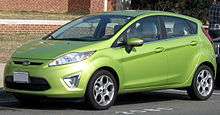
Unveiled at the 2009 Los Angeles Auto Show in December,[81] the sixth generation subcompact Fiesta is available in North America as a four-door sedan and five-door hatchback, with manual transmission or Ford's dual clutch automatic transmission. All models are manufactured at Ford's Cuautitlán Assembly Plant. Production ended on 19 August 2019.[82]
Ford dealers in the US offer optional laminated vinyl graphics applied to the car's exterior, expected to last 3 to 5 years before replacement.[83] Also, certain dealers partaking in a new Ford Retail program provide an "unwrapping" digital package loaded with a photograph of the buyer taking delivery of his/her new car. A 19 minute audio description of the car and its features is included, which can be played on the way home, then loaded along with its interactive program into the home computer via its USB connection.[84]
There are multiple lawsuits filed against Ford on behalf of Focus and Fiesta owners with dual-clutch transmissions alleging defective transmissions.[85] According to court documents, Ford issued multiple technical service bulletins but the problems were never fully resolved.[86]
Preliminary marketing
For the North American Fiesta, Ford initiated a marketing campaign in early 2009 called the Fiesta Movement, distributing examples of European Fiestas to applicants across the United States—to have the test drivers use popular Internet sites to share their experiences.[87] Subsequently, Ford brought the cars to public venues nationwide to offer 100,000 test drives over eight months.[88] One such event was offering free shuttle service in Chicago from a site near the Union Station commuter rail terminal to the Taste of Chicago event in Grant Park the week starting June 29, 2009. Late in July, six European Fiestas arrived in Halifax, Nova Scotia, to begin a similar demonstration tour across Canada.[89]
Following on the success of Fiesta Movement, Ford initiated Fiesta Movement 2 in December 2009 by calling for video applications to be submitted by the end of January 2010 for activities to begin mid-February.[90]
In March 2010, Ford worked with the television series American Idol to promote the Ford Fiesta in North America. Working with Ford designers, the final 12 contestants of the show created their own custom graphics on a Ford Fiesta, which were subsequently revealed on the show with fans given the chance to win one of the personalised cars.[91]
Launch
Production of Ford Fiesta for the North American market started in May 2010. Ford planned to have cars available for sale soon after. On June 18, 2010, it was reported that although dealers took deposits from over 2,000 customers for Fiesta and placed large orders as the car was heavily marketed, dealers and customers had not received cars that they expected to have arrived weeks ago in May.[92] In July, Ford said initial shipments were delayed for up to two weeks by Hurricane Alex that hit Northern Mexico in late June, and subsequently by Tropical Storm Bonnie.[93] As a result of the delays, Ford sent out US$50 gift certificates. By August 2010, Ford delayed some shipments because of a 'quality problem'. Ford claimed the issue was fixed and it was unlikely cars with defective parts would reach customers.[94]
Safety and recall
In 2017, Ford recalled 2014–2015 Ford Fiesta ST with 1.6 ecoboost engines because of a risk of engine fires caused by a “lack of coolant circulation”. The recall partly contributed to a charge of US$300 million by Ford.[95]
Trim levels
In North America, the Ford Fiesta is available in several trim levels:
S (2011–2013): The S was the most basic trim level of Ford Fiesta from 2011–2013. It included the following standard equipment: black steel wheels with plastic wheel covers, an A/M-F/M stereo with auxiliary input and four front speakers (no rear speakers), manual windows and door locks, cloth seating surfaces, manually-adjustable front seats, air conditioning, a 1.6L Inline Four-Cylinder (I4) engine, and a five-speed manual transmission. While some options were available for the S, no option packages were available, as this was the base model of Ford Fiesta. It was only available as a Sedan.
S (2014–present): The S trim level is the most basic trim level of Ford Fiesta. It includes the following standard equipment: black steel wheels with plastic wheel covers, an A/M-F/M stereo with Ford SYNC, a single-disc CD/MP3 player, auxiliary and USB inputs, and four front speakers (no rear speakers), manual windows, power door locks with keyless entry, manually-adjustable front seats, air conditioning, a 1.6L Inline Four-Cylinder (I4) engine, and a five-speed manual transmission. As a base model, the Ford Fiesta S offers no additional packages or options. It is available either as a Sedan, or, for the first time, a Hatchback.
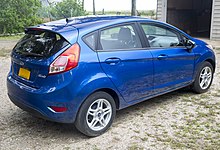
SE (2011–2013): The SE trim level was the mid-level trim level of the Ford Fiesta from 2011–2013. It added the following equipment to the base S: an A/M-F/M stereo with single-disc CD/MP3 player and auxiliary input, six speakers, and power windows and door locks with keyless entry. Available as either a Hatchback, or as a Sedan, the Ford Fiesta SE offered some option packages that added additional equipment.
SE (2014–present): The SE trim level is the mid-level trim level of the Ford Fiesta. It adds the following equipment to the base S: six speakers, power windows and door locks with keyless entry, and alloy wheels. Available as either a Hatchback or as a Sedan, the Ford Fiesta SE offers some option packages that add additional equipment.
SES (2011; USA): The SES (2011) for the North America market was the top-of-the-line trim level of the Ford Fiesta during the year 2011. It added the following equipment to the mid-level SE: Ford SYNC with 1x USB port, and 1x auxiliary input, leather seats with leather piping, a manually adjustable front driver and passenger seat, heated front seats, sixteen-inch alloy wheels, and touch-button security system with a push-button start using a key-fob. Only available as a Hatchback, the Ford Fiesta SES offered additional options or packages such as Winter Driving Package with heated mirrors and a single-color LCD head unit as the top-of-the-line Ford Fiesta model at the time.
SEL (2011–2012) and Titanium (2013): The SEL (2011 and 2012 models), or Titanium (2013 models only), was the top-of-the-line trim level of the Ford Fiesta between 2011 and 2013. It added the following equipment to the mid-level SE: Ford SYNC with USB and auxiliary inputs, leather-trimmed seating surfaces, a power front driver's seat, heated front seats, seventeen-inch alloy wheels, and security system. Available as either a Hatchback or as a Sedan, the Ford Fiesta SEL and Titanium offered no additional options or packages as the top-of-the-line Ford Fiesta model.
Titanium (2014–present): The Titanium trim level is the top-of-the-line Ford Fiesta trim level. It adds the following equipment to the mid-level SE: Ford SYNC with MyFord Touch (2014–2015 models), or Ford SYNC with SYNC3 infotainment system with touch screen, a 100-watt Sony premium audio system with external amplifier and rear-mounted subwoofer, leather-trimmed seating surfaces, a power front driver's seat, heated front seats, seventeen-inch alloy wheels, and security system. Available as either a Hatchback or as a Sedan, the Ford Fiesta Titanium offers no additional options or packages as the top-of-the-line Ford Fiesta model.
ST (2014–present): The ST trim level is the high-performance Ford Fiesta trim level. Based on the SE trim level, the Ford Fiesta ST adds the following equipment: a 1.6L EcoBoost Turbocharged Inline Four-Cylinder (I4) engine, a six-speed manual transmission, Recaro manually-adjustable front bucket seats, seventeen-inch grey-finished alloy wheels, and a unique front clip and body kit. Options include leather-and-suede-trimmed seating surfaces, navigation system, and sunroof. The Ford Fiesta ST is only available as a Hatchback.
Running changes
For the start of the 2012 model year, two new premium leather trim options and a sport exterior appearance package were made available for SES/SEL models, while several new colours were added for all models. At midyear, the hatchback became available in the previously saloon-only S trim level; as it includes a rear wiper and the same body colour one-slot grille as fancier models, externally only badging and a limited choice of colours distinguish it from the SE. For 2013 option packages have been simplified and a Titanium trim level replaces the former SES/SEL.
- Canada
Fiesta sales for Canada began in June 2010 for model year 2011.[96] Sales for the 5 door hatchback variant in Mexico started in 2011.[97]
2014 model year update (2013–2017) in North American market
_Ambiente_5-door_hatchback_(2018-08-06)_02.jpg)
Similar updates as those referred to as "facelift"-updates in the European market took place in the North American market as the 2014-model updates for the Ford Fiesta. These updates were first present in the Ford Fiesta 2014 (year model). The 2014 Ford Fiesta features redesigned front and rear fascias [98] (whereas the 2013 year and previous models in North American market do not have the trapezoidal, facelift grille). The SFE package based on the SE model includes a 1.0-litre three-cylinder EcoBoost engine.[99] As of February 2014, the 2014 Fiesta ranked number one among Affordable Subcompact Cars according to US News & World Report.[100]
Other markets
The sixth generation saloon was launched in India in July 2011 with both petrol and diesel variants.[24][101] The Fiesta received a September 2012 facelift with changes to the front, back and the interior.
Ford Fiesta for the Indian market has been finalised in both saloon and hatchback versions. It was put on show on April 15, 2011 in a Delhi mall. The model on show was a TDCi 1.6 Fiesta saloon but the variant was not disclosed. The sedan version has been launched in India. The top model comes with Bluetooth, Cruise control, Pull control, USB and Bluetooth / Voice Control as standard features. The other cars it will compete against will include Fiat Linea and Volkswagen Vento both of which have extended wheelbases, which the Fiesta does not.
A red/black edition debuted with an even more powerful version of the 1.0 EcoBoost three-cylinder with 138 hp (103 kW) and 155-lb ft torque.
Seventh generation (2017–present)
| Seventh generation | |
|---|---|
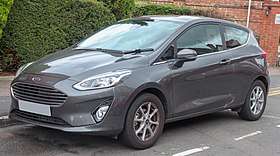 | |
| Overview | |
| Production | 2017–present |
| Assembly | Cologne, Germany (CB&A) |
| Designer | Ivan Telesca |
| Body and chassis | |
| Body style | 3/5-door hatchback |
| Platform | Ford global B-car platform |
| Related | Ford Puma (second generation) |
| Powertrain | |
| Engine |
|
| Transmission |
|
| Dimensions | |
| Wheelbase | 2,493 mm (98.1 in) |
| Length | 4,040 mm (159 in) (hatchback) |
| Width | 1,734 mm (68.3 in) (w/o mirrors) |
| Height | 1,483 mm (58.4 in) |
| Curb weight | 1,113–1,207 kg (2,454–2,661 lb) |
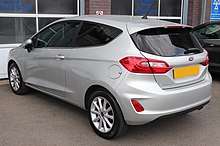
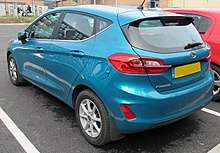
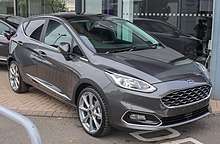

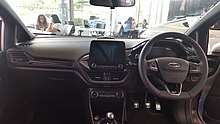
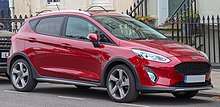
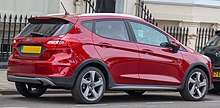
On November 29, 2016, the seventh generation Fiesta (Mark VII, or Mark VIII in UK) was announced in Germany, being bigger, roomier, safer, more efficient and more upmarket. The Fiesta range will expand to include new additions: a compact crossover, called the Fiesta Active, and the luxury Fiesta Vignale.[102]
The Ford Fiesta has been discontinued in the Australian & United States markets, according to Ford, due to the popularity of SUVs, and pickup trucks, such as the Ford Ranger & Ford Escape.[103] However, the Ford Fiesta ST will still continue to be sold in Australia due to popularity.[104]
Powertrain
| Model | Years | Type | Power, torque | CO2 (NEDC) | CO2 (WLTP) |
|---|---|---|---|---|---|
| Petrol engines | |||||
| 1.1 L Ti-VCT 70 PS | From 2017 | 1,117 cc (68.2 cu in) I3 | 70 PS (51 kW; 69 bhp), 108 N⋅m (80 lb⋅ft) | 101 g/km | 115 g/km |
| 1.1 L Ti-VCT 85 PS | From 2017 | 1,117 cc (68.2 cu in) I3 | 85 PS (63 kW; 84 bhp), 108 N⋅m (80 lb⋅ft) | 101 g/km | 114 g/km |
| 1.0 L EcoBoost 100 PS | From 2017 | 998 cc (60.9 cu in) Turbo I3 | 100 PS (74 kW; 99 bhp), 170 N⋅m (125 lbf⋅ft) | 97 g/km | 107 g/km |
| 1.0 L EcoBoost 125 PS | From 2017 | 998 cc (60.9 cu in) Turbo I3 | 125 PS (92 kW; 123 bhp), 170 N⋅m (125 lbf⋅ft) | 98 g/km | 107 g/km |
| 1.0 L EcoBoost 140 PS | From 2017 | 998 cc (60.9 cu in) Turbo I3 | 140 PS (103 kW; 138 bhp), 180 N⋅m (133 lbf⋅ft) | 102 g/km | 112 g/km |
| 1.5 L EcoBoost 200 PS | From 2018 | 1,497 cc (91.4 cu in) Turbo I3 | 200 PS (147 kW; 197 bhp), 290 N⋅m (214 lbf⋅ft) | ~114 g/km | 136 g/km |
| Diesel engines | |||||
| 1.5 L Duratorq TDCi 85 PS | From 2017 | 1,498 cc (91.4 cu in) I4 | 85 PS (63 kW; 84 bhp), 215 N⋅m (159 lb⋅ft) | 84 g/km | 97 g/km |
| 1.5 L Duratorq TDCi 120 PS | From 2017 | 1,498 cc (91.4 cu in) I4 | 120 PS (88 kW; 118 bhp), 270 N⋅m (199 lbf⋅ft) | 89 g/km | 107 g/km |
Marketing
On July 20, 2017, Ford UK released an advert of the Fiesta featuring actress Keeley Hawes.[105]
Fiesta ST (2018–present)
.jpg)
.jpg)
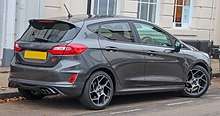
On 24 February 2017, the seventh generation derived Fiesta ST was announced. It features an all-new 200 PS three-cylinder 1.5-litre Ecoboost engine with turbocharger and cylinder deactivation technology.[106]
On 12 March 2018, Ford announced that a Quaife Limited-Slip Differential would be offered for the first time on the Fiesta ST as part of an optional "Performance Pack". The pack also includes a "ST" shift change light in the instrument cluster and launch control.[107]
The all-new Fiesta ST also includes three selectable driving modes, a first for the model. These include "Normal", "Sport" and "Race Track". Each mode changes the characteristics of the car including the steering feel, throttle response, deactivating the engine 'start-stop' feature and opening the flap in the exhaust which increases the sound of the car.[108]
The Fiesta ST was released on 7 May 2018.[109] Despite being heavier than the previous ST model, the new ST can go from a standstill to 62 mph (100 km/h) in 6.5 seconds. Power and torque have been increased to 197 bhp (200 PS) and 290 N⋅m (214 lbf⋅ft) respectively, which match the figures of the limited edition Fiesta ST200 of the previous generation. From launch, it is available in either a three-door or five-door body style, and comes standard with a six speed manual gearbox, with no option of an automatic. On 1 April 2019, the Fiesta ST-1 was discontinued, leaving only the ST-2 and ST-3 models.[110]
In April 2019, Ford announced a new limited edition model to the ST range called the "Performance Edition". Although named "Performance", the Fiesta ST does not gain any power upgrades to the standard ST. The car is based on the ST-3 model and comes with multiple options which would normally be a cost option to an ST such as, LED headlights, B&O sound system and Performance Pack. To differentiate the Performance Edition, the car comes with exclusive options, namely standard Deep Orange paint, lowered and adjustable ride height and lighter multi-spoke alloy wheels.[111]
The Ford Fiesta ST won Top Gear's Hot Hatch and Car of the Year for 2018.[112]
Commercial variants
All seven generations of the Fiesta have been available in sedan delivery/panel van format, although not in all markets. The Mark I, II and III versions feature the standard 3 door bodyshell with the rear side glass replaced by body coloured metal and a flat floorpan instead of the rear seats.
In 1991, a "high-cube" style van based on the Mark III front bodyshell but with longer wheelbase and Renault-derived rear torsion bar suspension was introduced and was named the Ford Courier. The Courier continued in the Mark IV style through until 2002, when it was replaced by the Ford Transit Connect.
For the Mark V, the standard Fiestavan version was based on the 3-door bodyshell rather than the taller 5-door version. The Mark VI Fiesta van was first introduced in the European market in mid-2009, a year after the original launch.
Motorsport
Rallying
Two Ford Fiestas starred in the 1979 Monte Carlo Rally — the British entry driven by Roger Clark and aided by co-driver Jim Porter, and a German entry piloted by Ari Vatanen and co-driven by David Richards.
Both cars were highly modified with special motorsport components throughout and featured pioneering Limited-slip differential (LSD) technology. The cars were powered by competition tuned versions of the 1,600 cc Kent crossflow engine — a later version of which appeared in the Mk 1 Fiesta XR2.
The two rally cars performed well in the arduous ice and snow that year. Roger Clark did not set any records but the German car achieved 9th position overall — a very encouraging result which sparked demand for sportier Fiestas.
Since this there have been sporting and "hot hatch" editions. Versions include Supersport, XR2, S(Sport), XR2i, Si, RS Turbo, RS1800, Zetec S, Zetec RS, and ST. All of these were powered by a range of engines from the Ford Kent engine to the Ford Duratec engine.
The Ford RallyeConcept in 2002 and Fiesta JWRC. Ford RallyeConcept has been realised through an intensely close collaboration between Ford RallyeSport, the motorsport experts behind the Puma Super 1600 and the Focus WRC rally cars, and Ford Design Europe, the creative team responsible for the new three-door Fiesta on which the RallyeConcept is based. Ford RallyeConcept's marriage of the motorsport engineer's objective for performance functionality with the eye for detail of the designer has been so effective that Ford has committed to an engineering development programme to bring a Fiesta-based rally car to reality. Aiming for FIA homologation by mid-2003, Ford RallyeSport is hoping that it will become Ford's next success story in national and international rallying. Fiesta Super 1600 debut Rally Greece 2004.
The "Fiesta Sporting Trophy" is a One Make Championship; beginning its 1st season in March 2006. It combines keen competition with equal performance and leaves the decision about winning or losing to the drivers and co-drivers capabilities. The driver, co-driver and mechanics work as a team to compete against the toughest adversary of all—the clock.
The Fiesta Sporting Trophy will be based around the Fiesta ST Group N car. The car has 165 PS (121 kW; 163 bhp) from the 2 L Duratec ST engine which when combined with the conversion kit from M-Sport, has been designed to provide all of the safety equipment and performance upgrades to enable the car to be competitive and reliable at any event around the world.
In March 2007, the Pirtek Rally Team introduced the Ford Fiesta Super 2000 rally car, which will compete in the Australian Rally Championship.
On November 18, 2009, Ford with M-Sport unveiled the Ford Fiesta S2000 Mark VI. Although not due for homologation until January 2010 it is set to make its debut as course car on the final round of the IRC series, Rally Scotland. The car had been built to compete mainly in the Super 2000 World Rally Championship. In 2013, M-Sport developed the Ford Fiesta R5, the successor of the Fiesta S2000; this was based on the 1.6 litre Fiesta ST, and was designed for the Group R5 class of rallying.[113] Fiesta R5 got Evo update in early 2016.
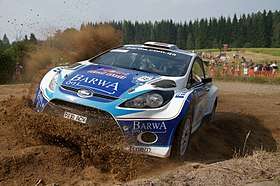
With new WRC regulations coming in 2011, M-Sport developed the Fiesta RS WRC, based on Fiesta S2000. It won six WRC rounds in 2011 and 2012, driven by Jari-Matti Latvala, Mikko Hirvonen and Mads Ostberg, but since M-Sport lost most of its manufacturer support for the 2013 season the car hasn't been able to win. In 2013, Thierry Neuville was the world championship runner-up, being a M-Sport junior works driver. Fiesta RS WRC has been very popular among private drivers, due to its good driveability, reasonable price and good availability.
The WRC regulations will be altered for 2017 and M-Sport has thus started developing the Mk7 Fiesta World Rally Car.
Fiesta ST Group N specifications
| Engine | 1,999 cc (122.0 cu in) Duratec engine. Four cylinders in line, DOHC, 16 valves, alloy cylinder head and block. Electronic multipoint fuel injection. |
|---|---|
| Power | 165 PS (121 kW; 163 bhp) at 5,800 rpm |
| Torque | 202 N⋅m (149 lb⋅ft) at 4,500 rpm |
| Transmission | Five-speed 'dog' engagement gearkit fitted to standard ST road car casing. Upgraded driveshafts fitted as standard. Plated LSD. |
| Suspension | Upgraded suspension of ST road car includes revised front knuckles and strengthened twist beam rear axle. Reiger dampers, adjustable for rebound, and revised spring rates. Uprated suspension bushes. |
| Brakes | Standard ST road car front and rear disc brakes. |
| Wheels | Gravel: 15-inch OZ Racing wheels
Asphalt: 17-inch OZ Racing wheels Wheels manufactured in both Super T and Rally Racing style. |
| Bodyshell | Multipoint roll cage designed by M-Sport, complying with FIA regulations. Includes three X braces in rear and twin tube door bars with no cross-over. |
| Electronics | 'Piggy back' loom supplements standard loom. Includes electronic circuit breaker and wiring for additional requirements. |
| Fuel tank | Standard 45 L (9.9 imp gal; 12 U.S. gal) tank with Kevlar composite moulded guard. |
| Dimensions | Length: 3,921 mm (154.4 in). Width: 1,683 mm (66.3 in). Height: 1,468 mm (57.8 in). Wheelbase: 2,486 mm (97.9 in). |
Rallycross
.jpg)
The Fiesta Rallycross Supercars version is a racecar with a 2.0 L Duratec turbocharged four-cylinder engine, running on petrol or E85 (85% ethanol/15% petrol). It produces over 550 bhp (410 kW; 560 PS) and 820 N⋅m (600 lb⋅ft). That propels the 2,600 lb (1,200 kg) rallycross-prepped Fiesta up to sixty in 2.2 seconds. The cars were more powerful (another 200bhp) than WRC cars.
The Fiesta Mk6 Rallycross cars made their US debuts in the 2009 Pikes Peak International Hill Climb in Colorado. Swedish team Olsbergs MSE announced the cars would later appear in ESPN's X Games 15 on 2009-08-02.[114] The two Olsbergs MSE Fiesta Mk7 Rallycross cars were based on the Fiesta hatchback model road cars, one with 3 doors, the other one a 5-doors version, but with all-wheel drive, powered by 2.0 L Duratec Ford engines capable of more than 800 bhp (600 kW) (for PPIHC only).
British company M-Sport also builds Fiesta Rallycross Supercars to Global Rallycross Championship teams Hoonigan Racing Division, Chip Ganassi Racing and Bryan Herta Autosport.
Driving a Fiesta, Tanner Foust won the 2011 and 2012 Global RallyCross Championship and was runner-up in the 2011 and 2012 FIA European Rallycross Championship. Toomas Heikkinen won the Global RallyCross Championship in 2013 and Joni Wiman and 2014. Other notable drivers include Marcus Grönholm, Ken Block and Brian Deegan.
An Olsbergs MSE RX Supercar Lite from FIA Rallycross Lite is also based on Ford FIesta.
Circuit racing
In the UK, the Fiesta is commonly used in club level motorsport series but has its national one-make series called the Ford Fiesta Championship. During its peak in the 1980s and 1990s, it had manufacturer support and it even was a support race to the British Grand Prix and numerous British Touring Car Championship rounds. The series has gone through numerous name changes including Ford Credit Fiesta Championship, Ford Fiesta Zetec Championship and BRSCC Ford Si Challenge and is nowadays run by the BRSCC (British Racing and Sports Car Club) as a club racing championship. The organisation also run the other series that consists of Fiestas.[115]
- Ford XR Challenge, for XR2 and XR2i models, also consists of the Escort XR models.[115]
- Ford Saloon Championship, mainly for a wider range of Ford models but Fiestas are mostly seen in classes C and E with a Mk 4 example winning the title outright in 2006 at the hands of Ollie Allen.[115]
The car has also been raced in the Touring-Light division of the Russian Touring Car Championship.
Fiesta drivers won the Super 1600 class of the European Touring Car Cup seven times from 2008 to 2016.
Sales and popularity
| Year | UK Sales | US Sales | Canada | México | Thailand |
|---|---|---|---|---|---|
| 2001 | 98,221[116] | ||||
| 2002 | 93,591[117] | ||||
| 2003 | 95,887[118] | ||||
| 2004 | 89,295[119] | ||||
| 2005 | 83,803[120] | ||||
| 2008 | 13,293(sedan)[121] | ||||
| 2009 | 117,296[122] | 5,989(sedan) | |||
| 2010 | 103,013 | 23,273[123] | 4,423[124] | 841(NA 5DR) 4,761(NA Sedan) | |
| 2011 | 96,112[125] | 68,574[123] | 13,064 | 1,433(NA 5DR) 8,503(NA Sedan) | |
| 2012 | 109,265[126] | 56,775[127] | 11,817 | 1,292(NA 5DR) 11,690(NA Sedan) | |
| 2013 | 121,929 | 71,073[128] | 9,851 | 2,963(NA 5DR) 10,753(NA Sedan) | |
| 2014 | 131,254[129] | 63,192[130] | 9,312 | 5,595[131] | |
| 2015 | 133,434[132] | 64,458[133] | 5,646 | 16,410[134] | 3,100[135] |
| 2016 | 48,807 | 3,093 | 14,315[136] | 409[137] | |
| 2017 | 46,249[138] | 1,838 | 7,028[139] | 203[140] | |
| 2018 | 51,730[138] | 1,082 | |||
| 2019 | 60,148[141] | ||||
The Fiesta has been Britain's most popular new car in 1990, 1991, 1996, 1997, 1998, and each year from 2009–2014.[129] By the time of the MK2 Fiesta's demise in early-1989, just under 1,300,000 had been sold in Britain since its launch twelve years earlier.
In June 2014, Ford claimed the largest market share in the UK of 12.87% – and almost half of those registrations belonged to the Fiesta.[142] By July 2014, the Fiesta became the UK's best-selling car of all time, with 4,115,000 sold.[143]
Awards and recognition
The 2011 Fiesta was one of the five finalists for the 2011 Green Car of the Year awarded by the Green Car Journal in November 2010, competing with two plug-in electric vehicles, the Nissan Leaf and the Chevrolet Volt (the winner), and two hybrid electric vehicles.[144]
- Winner of UK Design Council Efficiency Award for "exemplary contribution to the reduction of running and maintenance costs" in 1978. The award was presented by Prince Philip.
- Winner Australia's Best Small Car in 2004.
- Winner of Business Standard Motoring Jury Award, 2006.
- What Car's Best Used Supermini for 2006 – 1.4 Zetec 3dr 2003 – Runner Up Toyota Yaris 1.0 T2 3dr 2003.
- Winner of Brazilian Auto Esporte magazine Car of the Year in 2005 (Fiesta Sedan).
- Winner of Game Informer magazine Best Racing Games of the Year For Best Car in 2011 (Fiesta Gymkhana Car).
- Named Scottish Car of the Year 2008 at the 11th annual Association of Scottish Motoring Writers (ASMW) awards dinner in St Andrew's, Scotland.
- Named 'Car of the Year 1989' by Britain's What Car? magazine.
- Named 'Car of the Year 2009' by Britain's What Car? magazine.[60]
- Named 'Semperit Irish Small car of the Year' by tyre manufacturer Semperit
- Named 'Car of the Year' and 'Best Supermini' in Auto Express magazine's New Car Awards 2009.
- Fiesta ECOnetic named 'Least boring green car' of 2009 by Top Gear's James May.
- First minicar to achieve Top Safety Pick by the US Insurance Institute for Highway Safety (IIHS) based on front-, side- and rear-impact crash testing and roof-strength.
- Winner of the 2011 AJAC Car of the year award for Best Small Car under $21,000.
- Named 'Supermini of the Year 2013' by Britain's What Car?[145]
- Named 'Used Car of the Year 2012' by UK's CAP Black Book Car Guide.[146]
- Fiesta ST chosen Top Gear's Car of the Year 2013[147]
- Best Driver's Car Award – Bloomberg-UTV Autocar India Awards[148]
- Business Standard Motoring Jury Award 2006[148]
- Fiesta ST awarded Winner 'Best Performance Car Under $100k' in 2015 by Carsales during their Car Of The Year in Australia.
- Fiesta ST awarded Top Gear (TG) Magazine's car of the year 2019 – [149]
- Fiesta ST named Parker's car of the year 2019
- Fiesta named as 'Car Buyer car of the year 2019' and Fiesta ST named as 'Car Buyer hot hatch of the year 2019'
See also
References
- , Autoblog, July 2011
- , Best Selling Cars, March 2012
- , Best Selling Cars, March 2013
- "Retrospective: Ford Fiesta: 30th Anniversary". Channel 4. 2006-02-10. Archived from the original on December 17, 2009.
- Garnier, Peter, ed. (June 26, 1976). "World wide comment: Fiesta in France". Autocar. 144 (nbr 4155): 4–5.
- "Ford Fiesta Global Heritage" (PDF). Media.Ford.com. April 2010. Retrieved April 30, 2010.
- "Fiesta Tuareg Press Release & Press Photo". The Crittenden Automotive Library. 1979.
- "Project Bobcat | Mk2 Fiesta model information".
- "Still going strong, Ford's youthful-spirited Fiesta is celebrating its 30th birthday" (PDF). Ford Motor Company. August 25, 2006. Archived from the original (PDF) on September 30, 2008.
- "À côté du modèle actuel rebaptisé "Fiesta Classic", Ford commercialisera en fin d'année une autre Fiesta aux moteurs multisoupapes". Le Soir. September 2, 1995.
- Cleveland, Rob (March 1, 1996). "Vive la difference: Ford's Richard Parry-Jones relishes challenges of world cars". Archived from the original on July 16, 2017.
- de Partz, Yves (September 16, 1995). "Francfort, un salon exceptionnellement riche". Le Soir. Archived from the original on March 18, 2019.
- "Ford Fiesta becomes Best-Selling UK Car of All Time". Ford Motor Company. July 22, 2014.<
- de Partz, Yves (March 16, 1996). "La petite 121 bonne aussi pour la route". Le Soir.
- Samcor Mazda Soho: Tom Cruise, Brad Pitt, Meg Ryan, May 26, 1998
- "Facts & Figures: Ford Fiesta (99-03) 1.6 Zetec S 3d". Parkers.co.uk. Archived from the original on September 28, 2011. Retrieved March 18, 2011.
- "Fiesta 2002". HonestJohn.co.uk. Retrieved March 18, 2011.
- "Ford Fiesta One" (PDF). Ford Argentina. Archived from the original (PDF) on July 6, 2011. Retrieved August 3, 2011.
- "Introducción Fiesta .move". Ford.com.ve. Archived from the original on August 23, 2010. Retrieved August 26, 2010.
- "Viva o Novo". Ford. Retrieved August 26, 2010.
- Mazur, Eligiusz, ed. (2006). World of Cars 2006·2007. Warsaw, Poland: Media Connection Sp. z o.o. p. 150. ISSN 1734-2945.
- "2,000 Ford Fiesta Booked So Far". The Economic Times. Bennett, Coleman & Co. Ltd. November 26, 2005. Retrieved September 24, 2013.
- "Ford Ikon Discontinued". Articles.economictimes.indiatimes.com. April 7, 2011. Retrieved April 8, 2012.
- Yep, Eric (July 14, 2011). "Ford launches Fiest sedan in India". Wall Street Journal. Retrieved July 14, 2011.
- Thakkar, Ketan (July 16, 2012). "Ford India launches new variant of 'Fiesta Classic', rechristens it as 'Classic'". The Economic Times. Bennett, Coleman & Co. Ltd. Retrieved September 24, 2013.
- "Ford Classic Specification Data". Ford India. Archived from the original on September 27, 2013. Retrieved September 24, 2013.
- "Ford Fiesta ST". Parkers.co.uk. Archived from the original on November 16, 2010. Retrieved March 18, 2011.
- Morley, David (October 7, 2016). "Ford Fiesta XR4 2007–2008: Used car review". Retrieved January 6, 2019.
- "Ford Fiesta ST (preview)". Carenthusiast.com. Retrieved August 26, 2010.
- "Ford's New Fiesta Rally Car". Carkeys.co.uk. Archived from the original on March 23, 2006. Retrieved August 26, 2010.
- "Fiesta RS Concept". RS-Ford. February 20, 2011. Archived from the original on September 27, 2012.
- "New Sparkle for 2006 Ford Fiesta and Fusion". carpages.co.uk. September 13, 2005. Retrieved January 13, 2017.
- "Ford Fiesta "Dogbot"". stillking.com. Retrieved January 13, 2017.
- "Clever Fiesta, Stupid Dogbot". krop.com. Retrieved January 13, 2017.
- "New car sales 2007: The results". Motortrader.com. January 7, 2008. Archived from the original on March 9, 2008. Retrieved February 15, 2008.
- Nunez, Alex (February 9, 2007). "Ford bites MINI's flavour with UK "chequered flag" model". Autoblog.
- Colin Overland (March 21, 2007). "Driven: Ford Fiesta Zetec S 30th Anniversary". Channel 4. Archived from the original on September 15, 2008.
- Nunez, Alex (October 24, 2007). "Ford unveils Fiesta Zetec S 'Celebration' in UK". Autoblog.
- Joseph, Noah (June 26, 2008). "Ford UK offers Red edition Fiesta Zetec S". Autoblog.
- "2008 Ford Fiesta ST Mountune". Conceptcarz.com. March 1, 2008. Retrieved August 26, 2010.
- "New sporty limited edition Fiesta ST". Automobilesreview.com. June 10, 2008. Retrieved August 26, 2010.
- "Ford Fiesta Zetec Blue (2008) review". autoexpress.co.uk. January 9, 2008. Retrieved January 12, 2017.
- "Come In From The Cold With The New Ford Fiesta Zetec Blue". carpages.co.uk. November 3, 2007. Retrieved January 12, 2017.
- "Fiesta promotions (Archived)". ford.co.uk. September 7, 2008. Archived from the original on September 7, 2008. Retrieved January 12, 2017.
- Tadeo, Patrick Everett (March 29, 2013). "Do the Thais Know Something That We Don't?". Top Gear Philippines. Retrieved June 3, 2013.
- "Vehicle exterior".
- "ADAC Motorwelt". München. September 2008: 38. Cite journal requires
|journal=(help) - "Ford Fiesta "global car" begins production". Canadian Driver. August 14, 2008.
- "Ford Stages Global Reveal of All-New Fiesta Sedan in China". Ford Motor Company. November 18, 2008. Retrieved October 4, 2013.
- "Frankfurt preview: Goodbye Fiesta, hello Verve?". Channel 4. Retrieved May 9, 2011.
- "Ford revs up new small car prototype Verve". The Star. August 24, 2007. Retrieved May 9, 2011.
- "Automotive News Europe: Ford Verve Concept for Frankfurt". Autoweek.com. August 24, 2007. Retrieved May 9, 2011.
- "FORD VERVE CONCEPT HINTS AT FORD'S FUTURE SMALL-CAR DESIGN VISION". Archived from the original on January 18, 2008. Retrieved January 13, 2008.
- "Ford reveals more about its future small car". Media.Ford.com. November 19, 2007. Archived from the original on July 28, 2013. Retrieved May 9, 2011.
- "Ford Reveals Small-Car Vision for North America". Media.Ford.com. January 13, 2008. Archived from the original on July 28, 2013.
- "Ford Auto Shows – ', Verve Concept: Ford's New Vision for Small Cars', – 13 Jan. 2008". Autoshows.ford.com. April 19, 2011. Retrieved May 9, 2011.
- Horrell, Paul (November 2008). "Small Minded". Motor Trend. 60 (11): 44–50.
- "Ford Fiesta vs Vauxhall Corsa". Auto Express. August 2008. Retrieved February 15, 2009.
- "Ford Fiesta 1.6 (2008)". Carmagazine.co.uk. August 27, 2008. Retrieved May 9, 2009.
- "Fiesta named "Car of the Year" by What Car?, Britain's leading source of new car advice". Media.Ford.com. January 22, 2009. Archived from the original on January 25, 2009. Retrieved May 9, 2009.
- "Ford Fiesta Hatchback Full Review". What Car?.
- "Ford Remains Europe's No. 2 Best-Selling Car Brand in August and Year-to-Date". Ford Motor Company. September 16, 2010. Retrieved September 16, 2010.
- Kiley, David (September 4, 2008). "The 65 mpg Ford the U.S. Can't Have". BusinessWeek. Retrieved May 9, 2009.
- "Giving the Insight a Good Driver". AutoSpeed. Retrieved March 28, 2010.
- "New fuel-miser Ford knocks Prius off its perch". Smh.com.au. October 16, 2009. Retrieved August 26, 2010.
- "Lanzamiento: Nuevo Ford Fiesta 2018 en Argentina, desde $329.800". 16 Valvulas (in Spanish). 2017-12-11. Retrieved 2020-05-13.
- García, Gerardo (2017-11-24). "El Ford Fiesta estrena facelift, pero (quizá) no lo veremos en México". Motorpasión México (in Spanish). Retrieved 2020-05-13.
- "Ford lança New Fiesta 2018 reestilizado a partir de R$ 56.690". revistaautoesporte.globo.com (in Portuguese). Retrieved 2020-05-13.
- Mantilla, Oscar Julian Restrepo (2017-11-27). "Este es el Ford Fiesta 2018 brasileño, con nuevo diseño y cambios menores". El Carro Colombiano (in Spanish). Retrieved 2020-05-13.
- Carros, iG (2020-01-29). "Relembre a ascensão e queda do Ford Fiesta no Brasil - Home - iG". Carros (in Portuguese). Retrieved 2020-05-13.
- Mantilla, Oscar Julian Restrepo (2019-06-13). "El Ford Fiesta hatchback deja de producirse en Brasil y dice adiós a América Latina". El Carro Colombiano (in Spanish). Retrieved 2020-05-13.
- "Ford Reveals Fiesta ST Concept at Frankfurt Motor Show; Previews Future High-Performance Fiesta" (Press release). Media.ford.com. September 13, 2011. Archived from the original on September 23, 2011.
- "Ford Fiesta ST performance". autocar.co.uk.
- Jeffrey N. Ross. "2014 Ford Fiesta ST brings the heat to the B-segment". Autoblog.
- "Ford Fiesta". carsquare.com.
- Turkos, Brandon. "And the Top Gear UK Cars of the Year for 2013 are... LICENSE". AutoBlog. Retrieved July 2, 2017.
- "Fuel, performance and emissions". Config.ford.co.uk. October 9, 2008. Retrieved August 26, 2010.
- "Ford Fiesta Starts To Roll Off Rayong Plant This Month". Paultan.org. July 9, 2010. Retrieved September 13, 2010.
- "Ford Sales & Service (Thailand)". Retrieved September 13, 2010.
- "Green NCAP assessment of the Ford Fiesta". greenncap.com. 2019.
- "FORD'S NEW FIESTA TO DEBUT AT L.A. AUTO SHOW; FIESTA AGENTS BEGIN FINAL MONTH OF MISSIONS". BlueOvalNews. October 6, 2009. Retrieved March 28, 2010.
- "Ford Cuautitlan to cease Fiesta production in August; retooling for electric car comes next". MEXICONOW. Servicio Internacional de Informacion. December 12, 2018. Retrieved May 7, 2019.
- "Car Wrap Designs for the Ford Fiesta". Ford Fiesta Graphics. Archived from the original on April 16, 2010. Retrieved March 28, 2010.
- "Ford Fiesta 'Unwraps' Itself With Unique New Interactive Owner Delivery Experience". Media.ford.com. June 24, 2010. Archived from the original on August 11, 2010. Retrieved August 26, 2010.
- Martinez, Michael (May 30, 2017). "Focus, Fiesta owners sue Ford over faulty Powershift transmissions". Automotive News. Retrieved May 30, 2017.
- Wood, David. "Ford dual-clutch transmission lawsuit filed in Texas". CarComplaints.com. Retrieved May 30, 2017.
- "Ford names 100 Fiesta Movement 'agents' to hit the road, find adventure, share experiences". Media.Ford.com. April 7, 2009. Archived from the original on October 7, 2012. Retrieved June 6, 2009.
- "Be part of Ford's Fiesta Movement: 100,000 test drives planned for the new fuel-efficient Fiesta". Media.Ford.com. May 11, 2009. Archived from the original on June 19, 2009. Retrieved June 6, 2009.
- "New Ford Fiesta to make cross-country tour". CanadianDriver. July 29, 2009. Retrieved August 10, 2009.
- Shunk, Chris (December 3, 2009). "Ford accepting applications for Fiesta Movement 2". Autoblog.
- "Custom Ford Fiesta Designs from American Idol Finalists". Fast Fiesta. March 18, 2010.
- Jamie Lareau (June 18, 2010). "Ford Fiesta not yet in dealerships; dealers and customers get antsy". Autonews via Autoweek.
- Jeremy Korzeniewski (July 13, 2010). "Ford Fiesta shipments delayed due to hurricane". Autoblog.
- Chris Shunk (August 26, 2010). "Ford Fiesta shipments flowing again after faulty part fixed". Autoblog.
- Lynch, Jim (March 29, 2017). "Ford recalls 230,000 cars over potential engine fires". The Detroit News. Retrieved April 1, 2017.
- James Bergeron (April 26, 2010). "First Drive: 2011 Ford Fiesta". Canadian Driver.
- "Introducing the 2011 Ford Fiesta". Ford Motor Company. Archived from the original on December 2, 2008. Retrieved November 24, 2008.
- "The 2014 Ford Fiesta - View Full Gallery of Photos - Ford.com". ford.com. Archived from the original on December 3, 2012.
- Jeffrey N. Ross. "Ford expanding Fiesta line with high-po ST, frugal 1.0L EcoBoost". Autoblog.
- "Best Affordable Subcompact Cars Rankings – U.S. News Best Cars". rankingsandreviews.com.
- "Ford rolls out global Fiesta at Rs 8.23 lakh". Times of India. Retrieved July 15, 2011.
- "New 2017 Ford Fiesta: specs, official pictures and Q&A". Auto Express. Retrieved November 30, 2016.
- Wong, James (September 19, 2017). "FORD FIESTA AXED IN THE US, AUSTRALIAN PROSPECTS STILL UNCLEAR". Retrieved January 6, 2019.
- Wong, James (April 17, 2018). "FORD FIESTA: CORE RANGE AXED IN AUSTRALIA". Retrieved January 6, 2019.
- Stewart, Rebecca (July 21, 2017). "Ad of the Day: Ford gets nostalgic as it enlists Keeley Hawes to chart evolution of the Fiesta". The Drum. Retrieved August 2, 2017.
- "All-new 2018 Ford Fiesta ST unveiled with 197bhp". Auto Express. Retrieved February 24, 2017.
- "All-New Ford Fiesta ST Offers Limited-Slip Differential and Debuts Patented Technology for Ultimate Driving Dynamics". Retrieved March 15, 2018.
- "Driving Experience".
- "All-New Ford Fiesta ST Takes Hot-Hatch Performance to the Next Level with Industry-First Technologies" (PDF). May 8, 2018. Retrieved May 16, 2018.
- https://www.ford.co.uk/content/dam/guxeu/uk/documents/price-list/cars/PL-Fiesta.pdf
- "Performance Edition". Retrieved October 2, 2019.
- "Revealed: the 2018 Top Gear magazine awards winners". AutoBlog. Retrieved 26 Mar 2020.
- "Coming soon – Ford Fiesta R5". M-Sport. Archived from the original on October 7, 2013. Retrieved September 9, 2013.
- Joseph, Noah (July 2, 2009). "Ford attacking X Games with star-studded trio of Fiesta rally cars". Autoblog.com. Retrieved August 26, 2010.
- "BRSCC Ford Championships". Archived from the original on February 6, 2008. Retrieved February 15, 2008.
- "New car sales – seven record months, one record year". Smmt.co.uk. January 7, 2002. Retrieved April 8, 2012.
- "New car market scores a record breaking 2002". Smmt.co.uk. January 7, 2003. Retrieved April 8, 2012.
- "Consumer confidence drives record year". Smmt.co.uk. January 7, 2004. Retrieved April 8, 2012.
- "New car market in 2004 falls just short of record total". Smmt.co.uk. January 7, 2005. Retrieved April 8, 2012.
- "Record December after a tough year for new car sales". Smmt.co.uk. January 6, 2006. Retrieved April 8, 2012.
- "AMDA Mex (Industria Automotriz 2008–2014)" (PDF). Archived from the original (PDF) on January 20, 2016. Retrieved July 7, 2017.
- "2009 ends year with strong growth, December up 38.9%". Smmt.co.uk. January 7, 2010. Retrieved April 8, 2012.
- "U.S. Vehicle Sales by Model, 2007–2011". WardsAuto.com. Archived from the original on October 25, 2012. Retrieved January 15, 2012.
- Good Car Bad Car(Ford Fiesta Sales Figures)
- "New car market betters forecast..." smmt.co.uk. January 6, 2012. Retrieved February 23, 2016.
- "December 2012 and full year best sellers". smmt.co.uk. January 7, 2013. Retrieved February 23, 2016.
- "U.S. Light Vehicle Sales, December 2012". WardsAuto.com. Retrieved January 15, 2012.
- "Ford Motor Company Delivers Best Sales Year Since 2006" (PDF). Media.ford.com. January 3, 2014. Retrieved January 6, 2014.
- "FORD BOOSTS CV SALES AND EXTENDS UK MARKET LEAD IN 2014". ford.com.
- https://media.ford.com/content/dam/fordmedia/North%20America/US/2015/01/05/december2014sales.pdf
- "Sales Report เจาะลึกยอดขายรถยนต์รวมปี 2557 ที่ละเอียดที่สุดในไทย". February 2015.
- "Ford Closes 2015 in Style: Outpacing UK Industry Growth and Stretching its Market Lead | Great Britain | Ford Media Center".
- "Ford Motor Company December U.S. Sales Results" (PDF). Ford Motor Company. January 5, 2016. Retrieved January 15, 2016.
- Auto Dato (Ventas 2015, México: Nissan mantiene su liderazgo)
- "Exclusive Sales Report เจาะลึกยอดขายรถยนต์รวม ปี 2558 / 2015 ที่ละเอียดที่สุดในไทย". June 10, 2016.
- Auto Dato (ventas-2016-mexico-nissan-fue-el-lider-del-año)
- "Sales Report เจาะลึกยอดขายรถยนต์ ธันวาคม 59 – สรุปยอดรวมปี 2559 / 2016 แบ่งตาม Segment". January 26, 2017.
- "Ford F-Series Marks 42 Straight Years as America's Best-Selling Pickup, Topping 900,000 Sold in 2018; Ford Hits Nine Straight Years as America's Best-Selling Brand; Lincoln SUV Sales Up" (PDF) (Press release). Dearborn, MI. January 3, 2019.
- Auto Dato (Dossier-los-50-modelos-mas-vendidos-en-mexico-en-2017)
- "Sales Report เจาะลึกยอดขายรถยนต์ ธันวาคม 60 – สรุปยอดรวมปี 2560 / 2017 แบ่งตาม Segment". January 29, 2018.
- "F-Series Hits 43rd Straight Year as America's Best-Selling Pickup; Ford Achieves 10 Straight Years of Leadership as America's Best-Selling Brand; Lincoln SUV Sales Best in 16 Years" (PDF) (Press release). Dearborn, Michigan. January 6, 2020. Retrieved January 6, 2020.
- "Ford Fiesta Review 2014". motortorque.com. September 8, 2014. Retrieved September 8, 2014.
- Ramey, Jay (July 23, 2014). "Ford Fiesta becomes UK's best-selling car of all time". Autoweek. Retrieved July 23, 2014.
- "Chevrolet Volt Electric Car is 2011 Green Car of the Year". Green Car Journal. November 18, 2010. Archived from the original on November 24, 2010. Retrieved November 18, 2010.
- "2013 SOTY: Ford Fiesta". What Car?. January 9, 2013. Archived from the original on January 15, 2013. Retrieved January 9, 2013.
- Geraldine Ashton Green (January 1, 2013). "Ford Fiesta is 'Used Car of the Year 2012'". motoring.co.uk.
- "2013 Top Gear Awards". topgear.com. Retrieved December 4, 2013.
- "Ford Fiesta in India – Price, Mileage, Reviews, Images, Specs". Staff. Retrieved September 1, 2015.
- "TG mag's Car of the Year: the Ford Fiesta ST". Top Gear. January 4, 2019. Retrieved February 14, 2019.
External links
| Wikimedia Commons has media related to Ford Fiesta. |
- Ford Fiesta official US website
- Official Brochures: 2011, 2012, 2013, 2014, 2015, 2016, 2017
- Ford Fiesta official UK website
- Ford Fiesta Van UK official website
- Ford Australia Fiesta
- Ford Australia Small Cars: Fiesta & Fiesta ST